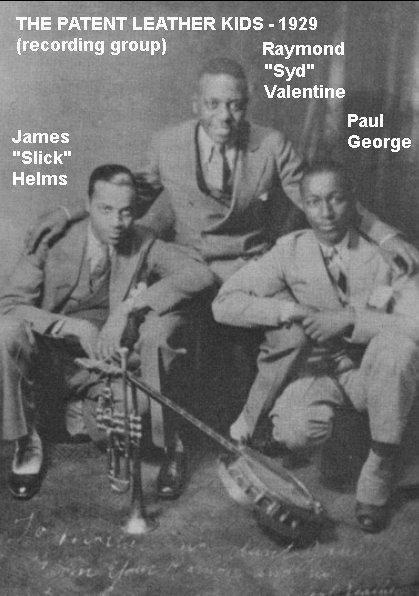
MORE THAN WORDS CAN SAY: THE INK SPOTS AND THEIR MUSIC
ADDITIONS AND ERRORS FOUND AFTER PUBLICATION
(in no particular order)
Over the years, since my book was published in 1998, I've uncovered a few errors. Also, I've found out some additional facts that are worth sharing with my readers. (In addition, I've learned dozens of ways to remove ink spots from virtually any kind of surface.)
Members (page xv) - The full list of permanent members should be updated as follows (additions to the original list are in bold italics):
Just to get it out of the way here and now, there are only five singers who can claim to be original members of the Ink Spots: Jerry Daniels, Deek Watson, Charlie Fuqua, Orville "Hoppy" Jones, and Bill Kenny (who was not there from the beginning, but was the most famous member nevertheless) - and all are dead! Of course there were others who sang with the Victor/Decca group (the only legitimate Ink Spots group as far as this history is concerned): Bernie Mackey, Cliff Givens, Billy Bowen, Huey Long, Herb Kenny, Harold Jackson, Adriel McDonald, Teddy Williams, Ernie Brown, Henry Braswell, Everett Barksdale, and Jimmy Cannady. There were also the pianist/arrangers: Bob Benson, Ace Harris, Ken Bryan, Bill Doggett, Ray Tunia, Harold Francis, and Fletcher Smith. This list comprises twenty-four people; there just weren't any others! Of course, there were occasional fill-in singers when someone was ill. For example, when Deek Watson was out with pneumonia in early 1943, they appeared with only three members for a while and then used Trevor Bacon (Lucky Millinder's vocalist), since both units were on tour together.
Charlie and Jerry - ERROR - all "Charlie and Jerry" should read "Jerry and Charlie". This was the actual name of the duo, even though Jerry Daniels always referred to them as "Charlie and Jerry". They had a series of 15-minute shows on WKBF (Indianapolis) for about a year and a half, beginning on June 19, 1931. For example, Jerry and Charlie were on WKBF at 10:45 PM on June 26, 1931, but by November 7, they'd been switched to 8:15, possibly indicating that they'd become popular. But then, times kept changing (8:30 on November 17; 7:15 on November 18; and 7:15 again on November 25). The last listing I can find for them is on January 3, 1933 at 11:45 AM. On July 29, 1931, they ("Radio Personality Boys In Songs And Dances") appeared at Lucky's Log Cabin Gardens in Logansport, Indiana. On May 5, 1933, "Jerry and Charlie Daniels" [sic] ("the dancing duet") appeared in a production called "Underneath The Harlem Moon" at an Indianapolis Y.W.C.A. They played one of the acts in a fictional Harlem night club. The February 24, 1934 Indianapolis Recorder said (in an article about Charlie marrying dancer Dorothy Hill): "Mr. Fuqua is now playing over WLW, assisted by Jerry Daniels, also from this city." It failed to mention that they were now part of the "King, Jack and the Jester".
Patent Leather Kids - ERROR - page 5. Member Sid Ballantine should be Raymond "Syd" Valentine (trumpet). Slick Helm should be James "Slick" Helms (piano). Paul George played the banjo, "Doc" Wheeler Moran was the drummer, and Charlie Fuqua played the guitar. Since there were supposedly ten of them originally, this leaves five others unaccounted for. They only lasted a short time before Valentine left, although, in the following year, he formed a trio by the same name. On October 2, 1929, Valentine, Slick Helms, and Paul George recorded some songs for Gennett. However, these tunes were jazz (Dixieland and Rag), and probably had little connection with what the original group had been doing. The Fred Wisdom that I mentioned was a pianist, but was a later member, after the group had been re-formed in the 1930s. Note that the group took its name from the 1927 Richard Barthelmess movie, "The Patent Leather Kid".

Slim Green - ERROR - page 4. In spite of Jerry Daniels telling me that Slim Green lived until the 1960s, he actually died of pneumonia, in Indianapolis, on April 22, 1938. His real name was Elmer Oliver (although he was sometimes referred to as Ollie Green), and his other nickname was "Simp". There was a huge article on the front page of the April 30, 1938 Indianapolis Recorder titled "Simp Green Funeral Rites Held". Green was well-known as a dancer ("Slim Green and his lightning feet"), singer, and guitarist. He was actually so famous locally that years later papers still talked about relatives of his who went into show business. Green had the Riff Brothers in 1932-3. (I had them breaking up in 1931.) Therefore, the photo on page 6 should be captioned "The Four Riff Brothers (1933)".
I found his obituary, in the April 30, 1938 Indianapolis Recorder to be fascinating. It read, in part:
Simp won note also for his attractiveness of dress. He usually brought every modern and new style of clothing to Indianapolis and sometimes created his own styles. He was fond of bright, shiny colors in clothing and often had as high as a dozen suits of clothing with extremely large bottom pants with high waists that came up to his shoulders. He wore suede shoes to match every kind of suit he owned and those shoes were sometimes blue, gray, pink, red, yellow, black, green, etc.
He wore shirts with very long collar points and sometimes his shirts were fastened on the side of the neck with buttons large as half dollars. These were not entertaining clothes. He wore them every day and was immaculately dressed at all times and the fashion. Sometimes he used two canes, walking with a straight one with a pearl top and sitting with another one while he displayed his latest attire to curious spectators.
His automobile usually had a large portrait of him painted on the side and often he would have it brightly polished and would cruise Indiana avenue with the car loaded down with girls gaily dressed and he being the only man in the bunch. The car was a touring [car]. Curiously enough Green, like other entertainers was practically penniless when he died. He had given the name of Green to his whole family; few people knew his name was Elmer Oliver.
Strangely, with all the write-ups he received, the only photos of Green seem to be the two in the Riff Brothers that accompany this page and the one that was printed with his obituary.
Slim Green made two records for Decca, both released in 1935:
48050 Cocktails For Two / I'm Gonna Sit Right Down And Write Myself A Letter (both recorded August 7, 1935)
48074 Shine / What's The Reason (both recorded August 9, 1935)
The paragraph on page 78 has to be slightly changed:
The Four Ink Spots organized in 1926, and except for one member of the group, Slim Greene [sic], who died in 1937 [sic; should be 1938], the personnel has remained the same. [My snarky comment about "before he did some of his best recording work no doubt" has to be removed.]
Jones & Campbell - appear April 9, 1928 at Tomlinson Hall in Indianapolis, as part of the Shriners' 16th Annual Easter Event (a musical comedy in three scenes called "Bright Lights"). Advertising the event, the April 7 Indianapolis Recorder said "Orville Jones and Mifflin Campbell, in their superb performance are foot artists of no mean ability, which will be proven in their dance act, which is the back bone of the show." On December 21, 1931, both Jones and Campbell ("tap dancers of note") and Charlie Fuqua and Jerry Daniels ("radio artists extraordinary") appeared at the Good Fellows Xmas Cheer Vodvil And Dance at the Walker Casino in Indianapolis. Because they were primarily dancers, Jones & Campbell don't seem to have ever had a radio program. The photo on page 2 should be dated a couple of years later; let's say "ca. 1928".
Percolating Puppies - On May 26, 1928 the Indianapolis Recorder published a photo of them. The article said they were "employed by Jack Dempsey at his camp when he was in training to fight Tunney the last time." It's an indistinct photo (I can't pick out Deek) that shows seven members with three coffee pots and two ukuleles or tipples. They're dressed in chef's costumes, which ties in with what Deek Watson later said. When they appeared at Crump's (in Columbus, Indiana) on May 17, they were called "A Hot Doggie Pack Of 7 Syncopating Scamps - led by Four-Dice Rastus" (presumably the one in the dark jacket in the photo). The June 16, 1928 Indianapolis Recorder mentioned that "A group of local boys making up what is known as the 'Coffee Pot band' was an added attraction [at the Walker Theater] Monday night. These boys sing, dance, joke and play their unique instruments in a way that seemed to please." Although "coffee pot band" is somewhat generic, since it follows the May 26 photo so closely, there's every reason to believe that this is them.
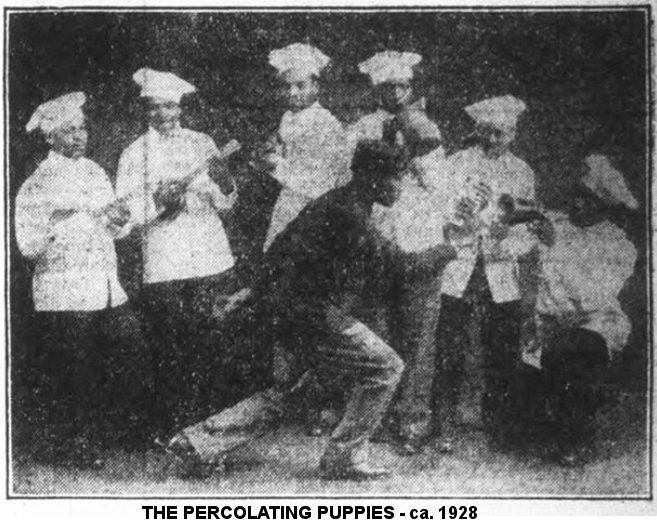
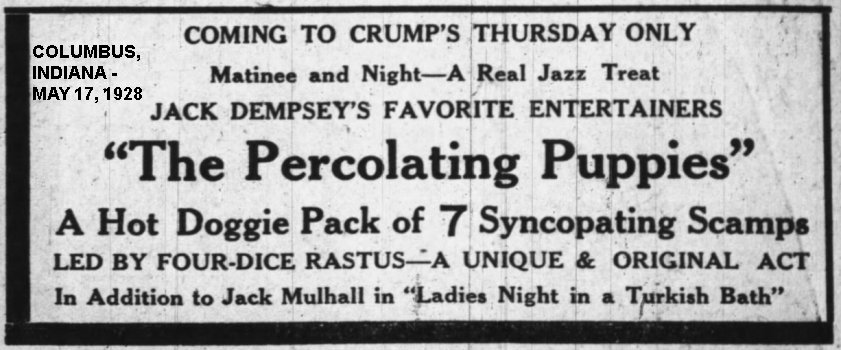
Peanut Boys - The Three Peanut Boys only seem to have had a couple of broadcasts over WFBE (May 10 and May 13, 1931). A May 23, 1931 article in the Pittsburgh Courier announced pianist Willard "Lord" Hamby joining the Peanut Boys, named as Leonard Reed, Mifflin Campbell, and Orville Jones. (Hamby had once been with Louis Armstrong [sometime prior to his June 1929 marriage] and then had a band called the Jungeleers [at least that's the way it was spelled in a 1929 radio listing].) My feeling is that the Peanut Boys only existed in April and May of 1931, since Leonard Reed was constantly involved with other projects. (Jones & Campbell then went back to being a duo and were named as dancers at the December 21, 1931 Good Fellows Xmas Cheer Vodvil And Dance at the Walker Casino in Indianapolis.) At least, Reed stayed long enough to be in a photo of the Peanut Boys; not so Hamby, who died in Cleveland, on January 2, 1934; he was only around 31. Therefore, the photo of the Peanut Boys on page 4, dated 1928, should now read "ca. April 1931".
Riff Brothers - Sometime after their December 1931 appearance, Hoppy Jones & Miff Campbell brought Ivory Watson into to their act; the name of the group is, however, unknown.
In the spring of 1932, Slim Green added them to his act at Tom Devine's Indiana Roof Ballroom (above the Indiana Theater). Slim, also known as "Simp Green", had been a singer and dancer at the Indiana throughout 1931. In its May 14, 1932 edition, the Indianapolis Recorder had a small article about the Riff Brothers, referred to as a "12-piece band and vodvil attraction". It went on to name them (although there were only 9 names): "Bernie Young [a bandleader], the Riff Brothers, Orville Jones, Simp Green, Ivy [sic] (Deacon) Watson, Mifflin Campbell; Hattie Snow; the Billy and Dolly dancing sister team and Baby Bojangles, a dancing, clever kid. The aggregation plans a ten weeks' tour of Indiana, Ohio and Illinois. Tom Devine is manager of the show." Hattie Snow, a blues singer (and the younger sister of Valaida Snow), appeared often with Simp Green. Presumably the three not named were members of Bernie Young's band. Note that this is the first mention of Watson being nicknamed "Deacon".
The unit then renamed itself the Four Riff Brothers and, over the summer of 1932, they toured with the Harlem Hot Shots. (Therefore, the photo on page 6 should be captioned "The Four Riff Brothers (ca. 1932)".) It looks like Slim appeared both as a single and with the Riff Brothers, since the September 24, 1932 Indianapolis News said: "Slim Green, eccentric dancer and singer, and the Riff Brothers, a quartet of entertainers, will appear on the Fountain Square stage for three days beginning Sunday. These Negro entertainers have been attracting the attention of major vaudeville circuits and plan to sign for an extended vaudeville tour soon. Recently they appeared at the Indiana Roof ballroom and 'The Trees.'" When they appeared at the Fountain Square, Slim also got separate billing from the Riffs, as he did on January 1-3, 1933, when they ("Indianapolis' Own Sons") were part of the "Harlem Hot Shots" revue at the Walker Theater, and again in February 1933, when they played the Capitol Theater in Indianapolis.
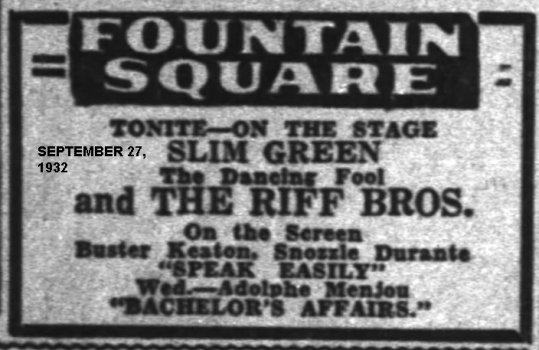
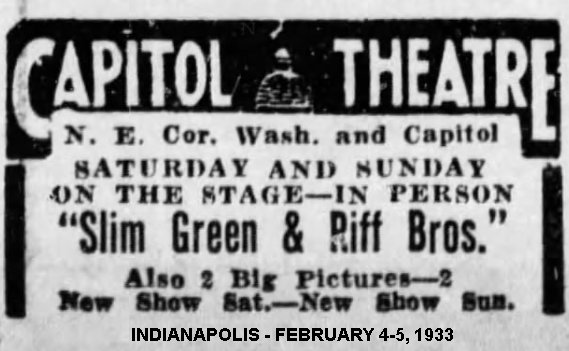
They (and the Charioteers) then became part of The Rhythm Club, a WLW show. Again, Slim's name appears separately from the Riff Brothers. The Pittsburgh Courier of April 29, 1933 said: "This Rhythm Club program of WLW is acclaimed in letter and editorial alike as being the most original and thoroughly entertaining half hour on the air [said some press agent]. Thousands of listeners have succumbed to its infestious [sic] gaiety and thousands follow the hilarious goings on of Brother Bones Hoppy, the undertaker who has given up his calling to devote himself to 'the whimsicalities of Swish;' Elder Rippey, the Riff, and Elder Johnson who sometimes builds small fires in the wrap-room." "Brother Bones Hoppy" is, of course, Orville Jones; this is the first reference to him being called "Hoppy". "Elder Johnson" (also known as "Elder Deac[on] Johnson") was played by Ivory Watson. It's a toss-up which one played "Elder Rippey" and which one was "The Riff" (Miff Campbell and Slim Green are the choices). Ivory Watson didn't stay too much longer, going out on his own in the late spring. (And now, his nickname had been solidified: "Deac", although he chose to spell it "Deek".) Presumably Watson was replaced, because they were still referred to as the Four Riff Brothers. But then, Slim Green left in September or October 1933 and, by November, at the latest, he was appearing in a duo with Johnnie Sullivan.
The photo below appeared in the May 6, 1933 Indianapolis Recorder. The accompanying caption named the members as: "Melvilli Campbell, Ivory Watson, Arville Jones, and ... 'Simp Green' Elmer Olliver." They were close. (The photo on page 6 of the book should be re-dated to 1933 and moved to that year's chapter.)
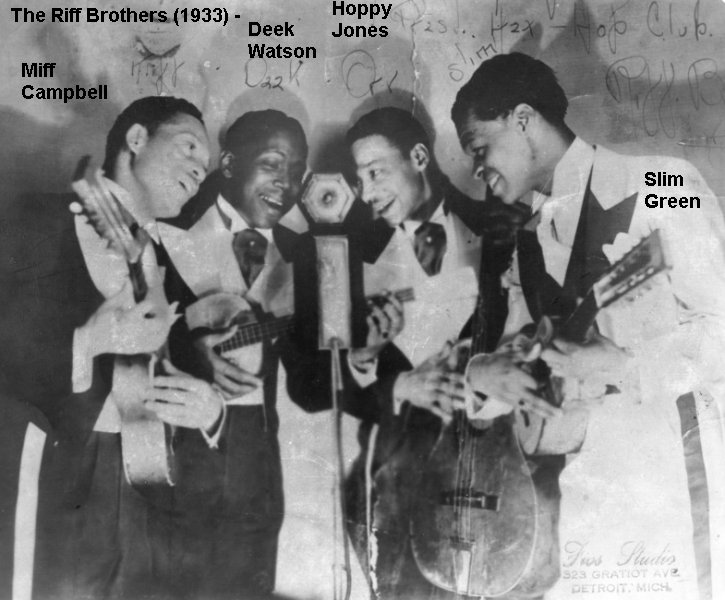
But Hoppy and Miff kept the group going somehow, although no new names were mentioned; they were still on WLW, until January 20, 1934. This is the last mention of the group and could signal when Hoppy left to join the King, Jack And The Jester.
King, Jack & the Jester - Around July 1933, Jerry Daniels and Charlie Fuqua were in Cleveland when they ran into Ivory Watson, who was performing as a solo act. These three alumni of the Indianapolis street corners decided to form a trio, first called the "Gates Brothers". They had a couple of broadcasts over WHK (Cleveland), for example on October 14, at 6:30. However, by the time they landed a job on WLW and its sister station, WSAI (both in Cincinnati), they had become the "Three Porters" (although I can't find any listings for them under that name). The December 9, 1933 Indianapolis Recorder said "Ivory 'Deac' Johnson ex of the Rhythm Club with Simp Green, is in Cincinnati with Jerry and Charlie. They are radioing for WLW as the Three Porters and will start another Rhythm Club soon." They quickly abandoned the "Three Porters" name and became the "King, Jack and the Jester".
The KJJ appeared on both WLW and WSAI from November 30, 1933 thru sometime in July 1934 (including almost every day in June 1934). At some point, Orville "Hoppy" Jones was brought in as the fourth member and they changed their name to the "King, Jack & the Jesters". However, only a couple of listings were as "King, Jack & Jesters" (the first of which was on February 17, 1934, so it's reasonable that Hoppy Jones was a member by that time; supporting this is that the last known broadcast by the Riff Brothers, of which Hoppy was a part, was on January 20). Unfortunately, this conflicts with the story of the origin of the group that Jerry Daniels told me. Because of this, and all the new information gathered above, I re-wrote the Prelude chapter, the 1933 chapter, and a lot of the 1934 chapter. The photo of the KJJ that appears on page 9 should be re-dated to early 1934 and placed in the 1934 chapter.
Re-written Prelude Chapter - The following should now be the entire Prelude: The 1920s To 1932 chapter (note that I combined the former "Prelude: The 1920s to 1931" and the former "1932" chapters; with the revisions, it just made more sense):
Where to begin with the story of the Ink Spots?
Let's go back to Indianapolis, Indiana during the Roaring Twenties. Let's begin with Orville "Hoppy" Jones and Mifflin "Miff" Campbell meeting in an ice cream parlor where Campbell was a waiter and Jones made ice cream. Finding a mutual interest in dancing (the nickname "Hoppy" seems to have come from his dancing moves), they formed an act, called "Jones and Campbell", that played in small-time vaudeville, carnivals, and clubs. For example, they appeared on April 9, 1928 at Tomlinson Hall in Indianapolis, as part of the Shriners' 16th Annual Easter Event (a musical comedy in three scenes called "Bright Lights"); they were praised for their dance routine. Advertising the event, the April 7 Indianapolis Recorder said "Orville Jones and Mifflin Campbell, in their superb performance are foot artists of no mean ability, which will be proven in their dance act, which is the back bone of the show."
Jones & Campbell (ca. 1928): Miff Campbell (left) and Hoppy Jones.
In April 1931, Leonard Reed was added, and "Jones and Campbell" became "The Peanut Boys" (or "The Three Peanut Boys"). Reed can be seen in the group's photo holding a tipple. Reed was a go-getter who was all over the Indianapolis scene. In August 1929, he and Jesse Gordon had been signed, as a singing ukulele act, for 35 weeks all over the Balaban & Katz theater chain. In spite of that, he (but not Gordon) was with the Whitman Sisters troupe the very next month. In November 1930 and February 1931, he was the Master Of Ceremonies for various stage shows; he also produced several of them. There was a small article in the February 14, 1931 Pittsburgh Courier that said "Leonard Reed, of the Walker Theater [in Indianapolis] is producing a new show, entitled 'All Rhythm Revue,' which opened here [Indianapolis] Feb. 9 for one week. The show will go out for the burlesque time, opening in Richmond, Ind., the following week. The show is carrying 20 people." In late March 1931, he was dancing and wise-cracking in a vaudeville show at the Empress Theater in Cincinnati.
The Peanut Boys (ca. April 1931): Miff Campbell, Leonard Reed, Hoppy Jones.
The Three Peanut Boys only seem to have had a couple of broadcasts over WFBE (May 10 and May 13, 1931, from 6:30-7:00).
A May 23, 1931 article in the Pittsburgh Courier announced that pianist Willard "Lord" Hamby had joined Leonard Reed, Mifflin Campbell, and Orville Jones in the Peanut Boys. (Hamby had once been with Louis Armstrong [sometime prior to his June 1929 marriage] and then had a band called the Jungeleers [at least that's the way it was spelled in a 1929 radio listing].) My feeling is that the Peanut Boys only existed for around two months: April and May, 1931, because, in early June, Reed was part of the "Sun-Tan Follies" show at the Roosevelt Theater in Pittsburgh. Jones & Campbell then went back to being a duo and were named as dancers at the December 21, 1931 Good Fellows Xmas Cheer Vodvil And Dance at the Walker Casino in Indianapolis. At least, Reed stayed long enough to be in a photo of the Peanut Boys; not so Hamby, who died in Cleveland, on January 2, 1934; he was only around 31.
Reed would have subsequent careers as a dancer, comedian, straight man (for Joe Louis' stage act), producer, and songwriter. As of the early 1990s, he was still active in show business.
On December 21, 1931, both Jones and Campbell ("tap dancers of note") and Charlie Fuqua and Jerry Daniels ("radio artists extraordinary", whom we'll meet in a short while) appeared at the Good Fellows Xmas Cheer Vodvil And Dance at the Walker Casino in Indianapolis. Because they were primarily dancers, Jones & Campbell don't seem to have ever had a radio program.
At the same time, Ivory Watson (later to be known as "Deacon", "Deac", or, as he spelled it, "Deek") was also making music. He began in Indianapolis in the mid-1920s with a "coffee-pot band" known as the "Percolating Puppies"; it was there that Deek learned to play the ukulele and the four string tenor guitar. Basically, coffee pot bands consisted of teenagers performing the music of their contemporary heroes, such as Duke Ellington, Cliff "Ukulele Ike" Edwards, Barney Rapp and the New Englanders, and the idolized McKinney's Cotton Pickers. In order to re-create band material, these groups had to be skillful at improvising a sound based on harmony vocals, often simulating wind, brass, and reed instruments with their voices, as well as "playing the strings", such as tipples, ukuleles, guitars, tenor guitars, banjos, and bass fiddles. A tipple, once a common instrument, was a little larger than a ukulele and had ten strings. A tenor guitar was a regular-sized guitar with the neck of a four-stringed banjo attached (most major guitar makers produced these back then).
The coffee pot was used as an echo chamber for a kazoo. By blowing kazoos into the pots, you could simulate a whole reed section. Jerry Daniels said that "the larger the coffee pot, the more resonant the tone." Therefore, the bands had various sizes of them. Many of the bands also had dancers; true self-contained entertainment units. And they weren't only trios, quartets, and quintets; some of these units could have as many as fifteen members (probably only the extremely good ones, otherwise it wouldn't have been financially feasible).
What was a coffee-pot band like? According to Deek Watson:
I had a group called the "Percolating Puppies." We played a small tea pot, a medium sized coffee pot, and a very large coffee pot, plus guitars. The sounds we were able to make were fantastic. We played on the streets. At the end of each such performance we passed the largest of the pots among the audience. The toughest thing about this way of making money was the fact that all of us had to keep our eyes on the cat who passed the collection for the evening, or else some of the money found its way from the pot to his pocket before dividing time arrived.
On May 26, 1928 the Indianapolis Recorder published a photo of the Percolating Puppies. The article said they were "employed by Jack Dempsey at his camp when he was in training to fight Tunney the last time." It's an indistinct photo (I can't pick out Deek) that shows seven members with three coffee pots and two ukuleles or tipples. They're dressed in chef's costumes, which ties in with what Deek Watson later said. When they appeared at Crump's (in Columbus, Indiana) on May 17, they were called "A Hot Doggie Pack Of 7 Syncopating Scamps - led by Four-Dice Rastus" (presumably the one in the dark jacket in the photo). The June 16, 1928 Indianapolis Recorder mentioned that "A group of local boys making up what is known as the 'Coffee Pot band' was an added attraction [at the Walker Theater] Monday night. These boys sing, dance, joke and play their unique instruments in a way that seemed to please." Although "coffee pot band" is somewhat generic, since it follows the May 26 photo so closely, there's every reason to believe that this is them.
Soon after this, Jones and Campbell recruited Ivory Watson into their act, but I don't know what the group was called. Note that Hoppy Jones not only danced, but played the "bass fiddle". Actually, Hoppy would do anything to avoid the clumsiness of a stand-up bass; in the beginning, he used a guitar, held upright and supported by the shaft of a cane (this can be seen in some of the photos); later he switched to a cello, tuned to sound like a bass.
Now, Slim Green enters our story. Slim went by several names: his real name was Elmer Oliver, but he was also known as "Simp Green" and "Oliver Green" (and sometimes "Greene"). He'd been a singer and dancer at Tom Devine's Indiana Roof Ballroom (above the Indiana Theater) throughout 1931, and had once been a part of a dancing act with Marion "Taps" Miller. In the spring of 1932, Slim Green added Hoppy, Miff, and Ivory to his Indiana Roof Ballroom act. The unit then renamed itself the Four Riff Brothers and, over the summer of 1932, toured with the Harlem Hot Shots.
In its May 14, 1932 edition, the Indianapolis Recorder had a small article about the Riff Brothers, referred to as a "12-piece band and vodvil attraction". It went on to name them (although there were only 9 names mentioned): "Bernie Young [a bandleader]; the Riff Brothers, Orville Jones, Simp Green, Ivy [sic] (Deacon) Watson, Mifflin Campbell; Hattie Snow; the Billy and Dolly dancing sister team and Baby Bojangles, a dancing, clever kid. The aggregation plans a ten weeks' tour of Indiana, Ohio and Illinois. Tom Devine is manager of the show." Hattie Snow, a blues singer (and the younger sister of Valaida Snow), appeared often with Simp Green. Presumably the three not named were members of Bernie Young's band. Note that this is the first mention of Watson being nicknamed "Deacon".
Slim appeared both as a single and as the fourth member of the Riff Brothers, since the September 24, 1932 Indianapolis News said: "Slim Green, eccentric dancer and singer, and the Riff Brothers, a quartet of entertainers, will appear on the Fountain Square stage for three days beginning Sunday. These Negro entertainers have been attracting the attention of major vaudeville circuits and plan to sign for an extended vaudeville tour soon. Recently they appeared at the Indiana Roof ballroom and 'The Trees.'" When they appeared at the Fountain Square, Slim also got separate billing from the Riffs, as he did In February 1933, when they played the Capitol Theater in Indianapolis.
The Riff Brothers (and the Charioteers) then became part of The Rhythm Club, a WLW show that had begun in April 1932. Again, Slim's name appears separately from the Riff Brothers.
Let's backtrack for a bit. In 1928, guitarist Charlie Fuqua had been a member of the Patent Leather Kids, which included Raymond "Syd" Valentine (trumpet), James "Slick" Helms (piano), "Doc" Wheeler Moran (drums), and Paul George (banjo). Since there were supposedly ten of them originally, this leaves five others unaccounted for. (Note that the group took its name from the 1927 Richard Barthelmess movie, "The Patent Leather Kid".)
Charlie was probably only with them for a matter of months before leaving to form a coffee-pot band with Jerry Daniels (whom he knew from the neighborhood, although they lived on different sides of a canal that ran through town). The third member of this unnamed aggregation was Bernie Mackey. (Since I didn't know at the time I interviewed Bernie that he was born in Miami, Florida, I didn't ask him how he ended up in Indianapolis.)
Charlie Fuqua ran a shoeshine stand across from the Stutz Bearcat automobile factory, and he and his pals got together to serenade the workers. They all sang and played guitar, with Jerry doubling on the ukulele. Fuqua (known as "Satchelmouth") had an uncle, Chauncey Lee, who was a classical guitarist and Fuqua's inspiration. (Note that Harvey Fuqua, of the famous '50s vocal group, the Moonglows, was Charlie's nephew - a musical family indeed! Interestingly, Charlie pronounced his name "FOO-kway," whereas Harvey pronounced it "FOO-qua.")
Around 1930, Charlie and Jerry decided to "turn pro" and left Bernie Mackey behind (we'll meet him again later, though). The duet was called, after a lot of thought perhaps, "Jerry and Charlie". With Jerry's tenor voice, ukulele, and tenor guitar, and Charlie's baritone/tenor voice, guitar, and tenor banjo, the two appeared in vaudeville and also had a series of 15-minute shows on WKBF (Indianapolis) for about a year and a half, beginning on June 19, 1931. For example, Jerry and Charlie were on WKBF at 10:45 PM on June 26, 1931, but by November 7, they'd been switched to 8:15, possibly indicating that they'd become popular. But then, broadcast times kept changing (8:30 on November 17; 7:15 on November 18; and 7:15 again on November 25). The last listing I can find for them is on January 3, 1933 at 11:15 AM. On July 29, 1931, they ("Radio Personality Boys In Songs And Dances") appeared at Lucky's Log Cabin Gardens in Logansport, Indiana.
Jerry & Charlie (ca. 1930): Charlie Fuqua (left) and Jerry Daniels.
We've now met Jerry Daniels, Charlie Fuqua, Orville "Hoppy" Jones, and Ivory "Deek" Watson. They'll be the main characters in the ensuing Ink Spots story.
Re-written 1933 Chapter - The following should now be the entire 1933 chapter:
From February 1933 to the end of the year (and into January 1934), the Four Riff Brothers (Slim Green, Ivory Watson, Miff Campbell, and Orville "Hoppy" Jones) got their own fifteen-minute sustaining radio program, the Rhythm Club, several times a week, on Cincinnati's WLW. (A "sustaining" show was one with no sponsor; you were an employee of the station itself, which paid for the show. At this time, commercial radio was still in its infancy, and anything and everything was being broadcast to determine listeners' tastes; the same thing was to happen in the early days of television.) Watson later said: "We went over so well that ... we broadcast any time they wanted - but always several times a week." This hints at why they were on with seemingly no schedule: they (and, I'm sure, many other acts) were just used whenever the station needed to fill a time slot.
Riff Brothers (1933): Miff Campbell (with tipple), Deek Watson (tenor guitar),
Hoppy Jones (with a tenor guitar that he's playing as a bass - he's cut down
a cane to make a support for it), Slim Green (tipple).
The Pittsburgh Courier of April 29, 1933 said: "This Rhythm Club program of WLW is acclaimed in letter and editorial alike as being the most original and thoroughly entertaining half hour on the air [said some press agent]. Thousands of listeners have succumbed to its infestious [sic] gaiety and thousands follow the hilarious goings on of Brother Bones Hoppy, the undertaker who has given up his calling to devote himself to 'the whimsicalities of Swish;' Elder Rippey, the Riff, and Elder Johnson who sometimes builds small fires in the wrap-room." "Brother Bones Hoppy" is, of course, Orville Jones; this is the first reference to him being called "Hoppy". "Elder Johnson" (also known as "Elder Deac[on] Johnson") was a character played by Ivory Watson. It's a toss-up who played "Elder Rippey" and who played "The Riff" (Miff Campbell and Slim Green are the choices).
Meanwhile, on May 5, 1933, "Jerry and Charlie Daniels" [sic] ("the dancing duet") appeared in a production called "Underneath The Harlem Moon" at an Indianapolis Y.W.C.A. They played one of the acts in a fictional Harlem night club.
Probably during the late spring of 1933, Ivory Watson left the Riff Brothers to do a solo act. (And now, his nickname had been solidified: "Deac", although he chose to spell it "Deek". For the rest of his life, he'd be known as "Deek Watson", although he was sometimes referred to as "Deacon".) Presumably Watson was replaced in the group, since they were still called the Four Riff Brothers. In September, Slim Green also left. (By November, at the latest, he was appearing in a duo with Johnnie Sullivan. Green had at least four releases on Decca's Sepia series in 1935, but died of pneumonia in Indianapolis on April 22, 1938.)
But Hoppy and Miff kept the Riff Brothers going somehow, although no new names were mentioned; they were still on WLW, until January 20, 1934. This is the last mention of the group and could signal when Hoppy left to join the King, Jack And The Jester (who'll be along in a few seconds).
One possible replacement in the Riff Brothers was Bill Hawkins. There were two small articles about him in the Indianapolis Recorder (December 11 and December 25, 1948) when he started on WJW as Cleveland's first black disk jockey ("Walkin' Talkin' Bill Hawkins"). Both articles said that he'd once been a member of the Riff Brothers. (However, his 1975 obituary didn't mention it, although it said that he was born in Birmingham, Alabama and had lived in Indianapolis until 1936.)
Meanwhile, Jerry and Charlie were touring the Midwest with the Whitman Sisters vaudeville show, one of the most popular programs in TOBA (the Theatre Owners Booking Agency), the main booking agency for black theaters. (No 1933 listings of the members of the troupe included their names; however, all this proves is that they weren't featured artists in the show.) On May 5, 1933, "Jerry and Charlie Daniels" [sic] ("the dancing duet") appeared in a production called "Underneath The Harlem Moon" at an Indianapolis Y.W.C.A. They played one of the acts in a fictional Harlem night club.
By July, the Whitman Sisters show having disbanded for the summer (theaters were not yet air conditioned), the pair found themselves on vacation in Cleveland. It was here that they ran into Ivory Watson, performing as a single. These three alumni of the Indianapolis street corners decided to form a trio.
First calling themselves the "Gates Brothers", they broadcast some shows on WHK (Cleveland), for example on October 14, at 6:30. However, by the time they landed a job on WLW and its sister station, WSAI (both in Cincinnati), they had become the "Three Porters" (although I can't find any listings for them under that name). The December 9, 1933 Indianapolis Recorder said "Ivory 'Deac' Johnson ex of the Rhythm Club with Simp Green, is in Cincinnati with Jerry and Charlie. They are radioing for WLW as the Three Porters and will start another Rhythm Club soon." On the original Rhythm Club, with Slim (or "Simp") Green, Deek played a character called "Elder Deac Johnson", so they didn't actually get his name wrong.
The Gates Brothers (fall 1933): Jerry Daniels, Deek Watson, Charlie Fuqua.
("King", "Jack", and "Jester" were written by Jerry years later. Note WHK microphone
and that Deke is wearing his Riff Brothers uniform.)
The "Three Porters" was just a passing phase and they finally settled on the "King, Jack and the Jester". Deek was the "King," Charlie the "Jack," and Jerry the "Jester". The first listing for the KJJ was on WSAI, November 30, 1933, at 2:45. Like many other acts of the day, they did a sustaining fifteen-minute show multiple times a week.
The King, Jack and the Jester not only sang their swing numbers, they did commercials for the Crosley Broadcasting Company (which owned WLW). Red Barber, future sportscaster for the Brooklyn Dodgers and New York Yankees, was their announcer.
[NOTE: the photo on page 13 should be moved to the next chapter and captioned "The Ink Spots (1934)".]
Re-written 1934 Chapter - The following should now be the beginning of the 1934 chapter:
At some point in 1934 (while still in Cincinnati), to add a final touch to the group, Deek Watson recruited his former "Riff Brother", Orville "Hoppy" Jones, as a fourth member. According to Jerry Daniels, they usually continued to call themselves the "King, Jack and the Jester", but occasionally it became the "King, Jack and the Jesters". Since almost all of the group's appearances on WLW/WSAI were billed in the singular, it's impossible to know exactly when Hoppy joined, but my guess would be in February 1934, since they were listed as the "King, Jack & Jesters" for the first time on February 17 and Hoppy's other group, the Four Riff Brothers, had broken up in January (their last listing was on January 20).
Hoppy was the grand old man of the group, turning 32 in 1934. That year, Jerry would have been 20, Deek would turn 25, and Charlie was 24. The Indianapolis News of February 17, 1934 missed out on its chance to straighten this all out when it reported that Charlie had gotten married to Dorothy Hill. It said (strangely) "Mr. Fuqua is a member of the musical team Jerry and Charlie, now of Cincinnati."
According to Jerry Daniels, when Grace Raines, pianist and vocal director at WLW, decided to relocate to New York, she asked the group to join her. (Note that, in 1952, Charlie Fuqua said that Grace Raines sent them to New York. Nothing ever said that she'd left Cleveland, and she was certainly back there in 1936.) This was too good an offer to pass up; Indianapolis, Cleveland, and Cincinnati were good for exposure and fine-tuning, but New York was one of the entertainment capitals of the country.
However, don't think that WLW was small-time radio. Known as "The Nation's Station", WLW advertised (in September 1938) that it had a staff of fifty radio voices and fifty-three musicians. On April 17, 1934, WLW, located at 700 on the AM dial, received permission to use an experimental 500,000 watt transmitter (by comparison, big stations today use one-tenth of that wattage). With that much power, they were heard from coast to coast (and even in England). The Federal Communications Commission (FCC) deemed this wattage excessive and unsuccessfully took the station to court to try to force it back to 50,000 watts. The station continued to transmit at 500,000 watts until March 1939, when the FCC finally won the battle and made it settle down to a more respectable 50,000 watts (even though crediting the station with materially contributing to radio knowledge).
It's unknown exactly when the King, Jack and the Jester left for New York, since there were contractual obligations that kept them in Cincinnati. During the first half of 1934, they appeared often on either WLW or WSAI (sometimes almost daily). I can find listings as late as July 31; however, in light of subsequent events, it would have been impossible for them to still be in Cincinnati at that late date. There are two choices that suggest themselves. The first is that these listings were sent out to newspapers ahead of time. This is true to some extent, but it probably wouldn't have been more than two weeks at most. The second is that, because WLW was such a powerful entity, they could finish out their contract (which probably lasted until the end of July) by doing remote broadcasts from New York. This means, of course, that they could have left at any time after mid-June (there was an ad for them appearing at a WLW function, at the Zoo Opera House, on June 17, so they were still in Cincinnati then).
(I'm not sure what this proves, if anything, but the July 28, 1934 Indianapolis Recorder mentioned that an Indianapolis women's club had done some entertaining the day before. One of the guests was Dorothy [Mrs. Charlie] Fuqua of Cincinnati. All we can reasonably infer is that wives weren't taken along on this exploratory trip to New York.)
Throughout the first half of 1934, they had built up a following among midwestern listeners. Although there were many black vocal groups around, few got much recognition. Two who did were the extremely popular Mills Brothers (who had a 1931 smash with "Tiger Rag"), and the Three Keys. Jerry Daniels pointed out that the sound of his group was quite unlike the more polished style of these contemporaries. The style of the King, Jack and the Jester (and also of the early Ink Spots) was "swing," derived from the big-name jazz bands, vaudeville acts, and the coffee-pot street-corner bands of Indianapolis.
What strains the imagination is that Hoppy was added as they were going to New York. This would mean that in a matter of a few weeks, they would have had to add Hoppy, change all their arrangements to accommodate a fourth part, move to New York, change their name to the "King, Jack and the Jesters", and then change it again, this time to the "Four Ink Spots". (Their first known appearance as the Ink Spots was at the Apollo Theater, the week beginning August 3.) It's more reasonable to believe that Hoppy was added while they were still on radio in Cincinnati (again, my guess would be February). This way, they could break him in. It's possible that they kept their old name in case he didn't work out.
But finally, it was time to say farewell to Cincinnati and off to fame and fortune they went. (Actually, it took a bit longer than they'd hoped.)
When the King, Jack and the Jesters first got to New York, they faced stiff competition within the entertainment world, as well as a problem over their name. Orchestra leader Paul Whiteman already had a vocal group within his band called the "King's Jesters", and when a conflict arose, it was not difficult to figure out who would yield. However, considering that WLW could be heard all over the country since May 2 (when President Franklin D. Roosevelt pressed a key to officially inaugurate the station's 500,000 watt transmitter), I imagine that Whiteman contacted them before they even reached New York. [It was the same key, by the way, that President Woodrow Wilson had pressed to open the Panama Canal.] The newcomers from the Midwest renamed themselves the "Riff Brothers" for a short while, and then the "Four Ink Spots".
Many fanciful stories have been told about the origin of this name. The truth, however, is rather dull: their manager simply sat down and decided on it. It's a little harder to determine just who this manager was: Jerry Daniels said that the name came from Moe Gale; Deek Watson said it was a Mr. Heffman (Heffman and Wright were their first managers when they got to New York; they also managed bandleader Ozzie Nelson and comedian Joe Penner). They then switched to Moe Gale, owner of Harlem's Savoy Ballroom, but it isn't clear exactly when he took them over.
The Ink Spots (1934): Jerry Daniels, Deek Watson, Hoppy Jones, Charlie Fuqua.
Hoppy autographed it to Miff Campbell: "To my best & only pal, Miff - Orville".
Nor were they the first to use "Ink Spots". When they came to New York, that name was being used by a small-time group, the Three Ink Spots, who were going nowhere. Somehow their manager (whoever he may have been) got involved, and decided to let the Riff Brothers try the name, which was tailor-made for a black group. Thus, they became the "Four Ink Spots".
These are the Three Ink Spots, identified as J. Sterling Russell, Hamilton Stewart, Jr., and P. Clifton Armstrong. As the Sterling Russell Trio, they were part of Bennie Moten's Orchestra and were featured on some Victor recordings ("Imagination" and "The Only Girl I Ever Loved") waxed on December 13, 1932. (They really aren't very good.) By May 1934, they'd changed their name to the Three Salesmen
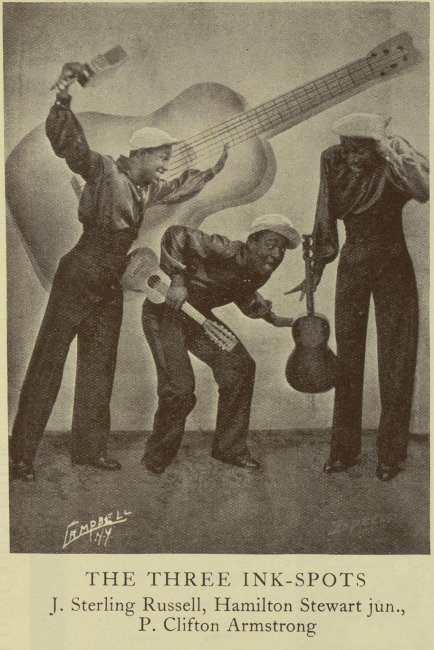
The December 10 Pittsburgh Courier said: "The Three Ink Spots (song masters) are featured with the Kansas City unit in what it takes to 'send' you." The December 11 Newport News Daily Press had this (talking about the Bennie Moten show): "During the evening a floor show was given by a group of performers known as the 'Three Ink Spots'."
Note that there was another Three Ink Spots group who were in a play called "Beale Street" that opened in January 1935. They were named as John L. Butler, Chas. Carroll, and Woodrow Wilson Brown. There's a real possibility that there were several groups by that name since, in 1932 the Three Ink Spots were described in different write-ups as "inimitable dishers of harmony", "flash dancers" (that is, acrobatic tap dancers), "banjo players", "three boys and guitars", "whirlwind dancing", and "song masters". There was even a Three Ink Spots radio show in 1933. And, there were amateur groups by that name all over the country throughout the 1930s.
Whoever they might have been, there was a Three Ink Spots that played Mother Kelly's in Miami in January 1942. They may be the same group that was at Atlantic City's Steel Pier in March of that year, headlining a vaudeville show at the Music Hall.
How about this? The February 16, 1918 Indianapolis News talked about a show at the Lyric Theater: "The Three Ink Spots, a trio of colored boys who sing, dance and play the piano, will provide a novelty. One of the 'spots' is none other than Sugar Bailey, the little, fat newsboy of dusky hue who sang and danced on local street corners for several years past to the delight of hastily gathered audiences." (The other two were "Bubbles" Sudry and "Lasses" Washington.) So, Indianapolis was host to an Ink Spots group some 15 years earlier.
The Spots were lucky to hook up with Moe Gale, who not only managed many of the black acts of the day, but also owned the Savoy Ballroom on Lenox Avenue and 140th Street (the most popular nightclub in Harlem in the '30s, with the largest dance floor, nicknamed "The Track").
The Gale Brothers: Moe (right) and Tim.
The Four Ink Spots' only two documented New York appearances in 1934 were at the Apollo Theater (August 3 through August 10) and the Roxy Theater (August 24 through August 30), along with the movie "Charlie Chan's Courage".
The Ink Spots (1934): Jerry Daniels, Deek Watson, Charlie Fuqua, Hoppy Jones.
It's worth noting that the next time they played the Apollo (the week of November 8, 1935), they'd become so well-known on radio, it wouldn't take an arrow to point them out; they were the headliners ("Singing, Playing, Dancing Sensations").
Moe Gale also managed to get them into a movie short, "Oh, What A Business", an 18-minute extravaganza starring veteran Vaudevillians Smith & Dale, singer Gloria Grafton, and a musical group called the Russian Revels. Filmed at the Biograph Studios in the Bronx (sometime in August or September 1934), it was released on November 28 (although it didn't play in Harlem until May of the following year). In it, they supposedly sang "Tiger Rag" and "Don't 'Low No Swingin' In Here". ERROR - I had the movie from 1935.
Probably Gale's most important act was the orchestra of drummer William Henry "Chick" Webb, the Savoy's unofficial house band. Edgar Sampson, one of Webb's arrangers, wrote the tune "Stomping At The Savoy," later recorded by the Ink Spots, as well as by Webb, Benny Goodman, and Ozzie Nelson, among many others. In 1935 Webb hired neophyte singer Ella Fitzgerald. This was the first big break for "Miss Ella" (who had really wanted to be a dancer). Later in our story we'll meet her again.
[The entire 1934 chapter that currently exists should be appended to all of the above. Note, however, that they returned from England on the S.S. Aquitaina on December 25, 1934 (not December 26 on the Queen Mary, as Deek claimed).]
The "Real" Genesis Of The Ink Spots - Once the Ink Spots became famous with "If I Didn't Care", Moe Gale's publicity agents went into high gear. Consider these two mentions of the group in the Brooklyn Daily Eagle:
September 5, 1939: "The Four Ink Spots, smash radio quartet, are all former members of Brooklyn church choirs."
September 19, 1939: "The Four Ink Spots, Brooklyn's youngsters who went from choir music to swing, open tomorrow at the Manhattan Paramount."
By October 11, 1939 the story given to the New York Daily News had changed it:
The Ink Spots, NBC's popular colored quartet, are currently featured at the Paramount Theatre with Glenn Miller's Orchestra, earning $1500 a week. Less than ten years ago Orville (Happy [sic]) James [sic], and Deacon (Ivory) Watson, two of the foursome, worked at the same theatre as porters for $18 a week.
On January 23, 1940, the Daily News blurb had been changed to read:
The Four Ink Spots, of radio fame, who are appearing at the Paramount this week, once worked as porters at that very theater. [So it's gone from two of them to all four.]
This one must have caused riotous laughter when it appeared in the April 5, 1940 Indianapolis Recorder. After all, the people of Naptown knew the group's history.
There's another ironical twist in their $2000 per week appearance at the Paramount. For it was that very same theatre almost ten years ago that three of the Ink Spots, Ivory Watson, Orville Jones, and Charlie Fuqua worked as assistant stagehands. They used to sneak their fourth harmony mate, Billy Kenny, into the theatre after the managers had left, and the four of them would run through their vocal arrangements while the rest of the stagehands and porters would gather in the front rows to coach and criticize them. They might have kept on practicing for years with hardly any other results if two of the Paramount managers hadn't forgotten their umbrellas one rainy night and returned to catch the Ink Spots in the midst of their act. The managers evidently didn't think they were good - because the Ink Spots were fired.
[New Stuff] Billy Kenny, the tenor, knew a theatre manager out West. So grimly they followed Greeley. [Horace Greeley, a newspaper editor who became famous for the phrase "Go West, Young Man".] They never did meet Kenny's friend the manager. It was a patrolman who tipped off the wandering quartet to visit radio station WLW. Twenty-four hours after their audition they were appearing on that station as regular artists. Two weeks later they were being sponsored by the biggest firms in the Middlewest. But their fame was only local and in their breasts burned a desire to make good where the Paramount moguls could see them and feel sheepish. [Can it be that every single press agent made up his own story?]
The December 6, 1940 Brooklyn Eagle combined stories:
If you were one of the customers who used to drop pieces of paper on the plush Brooklyn Paramount carpets about nine years ago - a member of a famous singing quartet probably portered it safely out to the rubbish heap. [Notice how it's gone from the Manhattan Paramount to the Brooklyn Paramount.]
If you lived around the neighborhood of Marcy and Lafayette Aves. About that many years ago you must have passed the St. Augustine Church. On a Summer's day, if you stopped to listen to its fine choir from the street, you were listening to four colored lads, who are now the highest paid quartet in the world.
They are the Four Ink Spots, who are celebrating their sixth anniversary as a quartet this week coincident whith their engagement at the New York Paramount Theater - where they also portered backstage some nine years ago. [What a coincidence; they were porters at both Paramount Theaters!]
In fact, it was their portering period there that lead to the formation of the quartet. They were fired when the manager returned one night for his umbrella and caught the Spots singing and dancing instead of sweeping. They recruited Jerry Daniels, another aspiring singer, and formed a quartet....
The February 13, 1944 article in the Minneapolis Star Tribune gave a different version:
The Ink Spots, singing quartet dearly beloved by jukebox operators, came to fame through an accident.
The whole thing started when Orville (Hoppy) Jones and Ivory (Deac [sic]) Watson, backstage porters at the Paramount theater, New York, used to do a little harmonizing while cleaning up, aided by Charlie Fuqua, a guy with a guitar who just happened to be around.
Bob Weitman, manager of the Paramount, heard and encouraged them [funny, I thought he'd fired them], then interested Moe Gale in the team. He added Billy Kenny, the tallest and highest-voiced of the singers, to the aggregation.
By the time this article appeared in the March 12, 1944 Courier-Journal (Louisville, Kentucky), the story had gotten more refined and they'd now been tutored:
"We were porters at the Paramount in New York," began Deek Watson.
"One night after the show we were singing on the stage and -" began Hoppy Jones, the "talking bass".
"This Moe Gale comes in and says 'go right ahead boys,'" began Bill Kenny, the poet of the group.
"We went to Europe the next day," began Bernie Mackey.
If I had known about these articles back in the 1990s, I wouldn't have wasted my time researching their origins in Indianapolis. Note that, when they were about to play Windsor, Ontario in December 1941, Deek gave a more realistic version to the Windsor Star (December 11). He said that they'd started 12 years before in Indianapolis as the 4 Riff Brothers and became popular through radio programs in Indianapolis, Cincinnati, and Cleveland. With that article, they ran a photo I've never seen before:
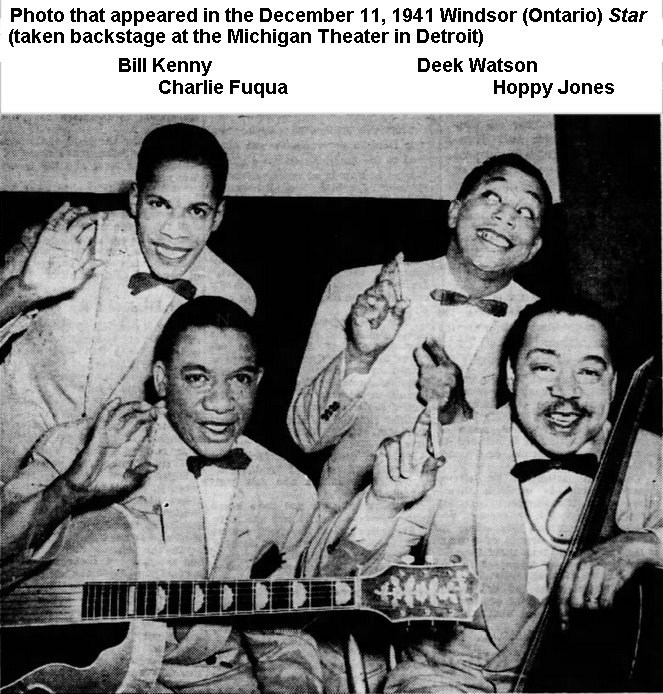
Appearances with Jack Hylton - Jack Hanna has documented some of the appearances the Ink Spots made with Jack Hylton (as part of the "America Calling" portion of his revue): early October 1934 - the Hippodrome (Birmingham); October 15-20 - the Palladium (London); the Hammersmith Palais (London); the Paramount (Manchester); November 12-18 - the Empire (Edinburgh); and November 19-24 - the Empire (Glasgow). There were also BBC radio broadcasts on at least December 7, December 8, and December 12 (when they sang "Nagasaki").

First known "Ink Spots"-type arrangement - "Tune In On My Heart", sung over WEAF on February 15, 1938. It has Kenny's high tenor ballad lead, Charlie's guitar intro, and Hoppy's talking bass bridge. This is a few months earlier than "I Wish You The Best Of Everything" that was mentioned on page 50. However, consider this: the August 29, 1936 New York Age said: "First the Mills Brothers stepped down from the airwaves and the Three Keys moved in with better voices, harmony plus more rhythm than ever. They faded and now the Ink Spots paced by top tenor, Bill Kenny, have spread eagled the entire field with a mighty bright future facing them." Therefore, whatever Bill Kenny was doing in 1936, it certainly stood out on the radio, even if not in recordings.
Bob Benson - ERROR - the photo on page 77 shows pianist Asa "Ace" Harris, not Bob Benson. Here's a photo of the group with Bob Benson at the piano. The others, left to right are: Charlie Fuqua, Deek Watson, Hoppy Jones (who's actually holding a bass!), and Bill Kenny.
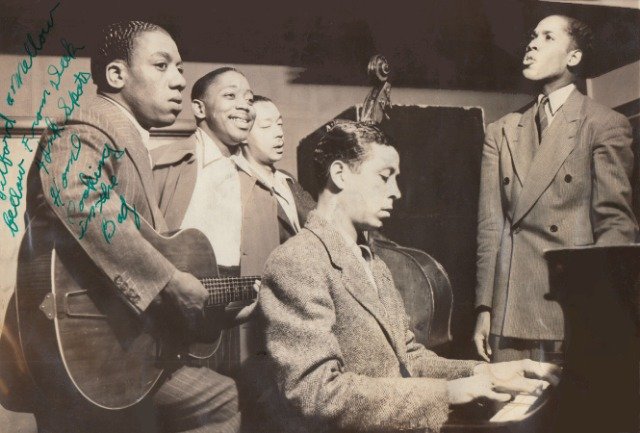
A blurb in the June 8, 1940 Afro-American has Bob Benson leaving and Ace Harris joining. ERROR - on page 79, I had him leaving in 1941.
Bob Benson was born in Mercer County, West Virginia, either in the town of Simmons (per his death record) or Bluefield (per every other record). Bob supposedly knew the members of the Ink Spots in Indianapolis, but didn't join them until 1938, in New York. After leaving them, he relocated to Detroit, where he died in 1945. He was only 36.
Asa "Ace" Harris - Joined the Ink Spots as pianist and arranger around May 1940 (not 1941, as on page 79). From Fort Pierce Florida, he'd first been the pianist for Billy Steward's Celery City Serenaders (a Florida territory band), and then the famed Sunset Royal Orchestra. When he left the Ink Spots in 1942, he went with Hot Lips Page and Erskine Hawkins. To narrow it down a bit, there was a sentence in the April 18, 1942 Pittsburgh Courier that said: "Ace Harris is no longer the piano man with the famous Ink Spots."
Note that there was a pianist named Johnny "Ace" Harris, who died in April 2000 at the age of 83. For many years, he claimed to have been the Ace Harris in the Ink Spots; he wasn't.
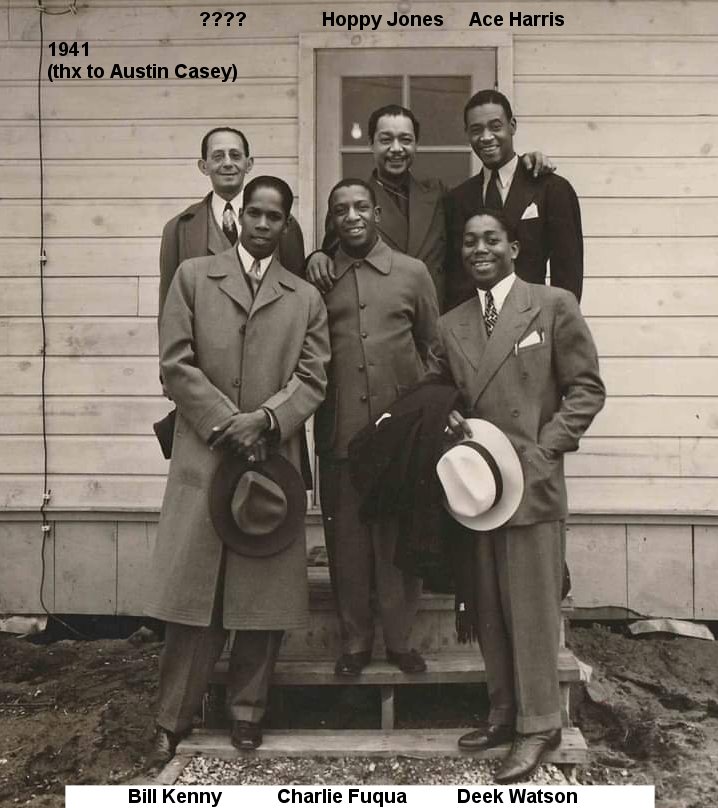
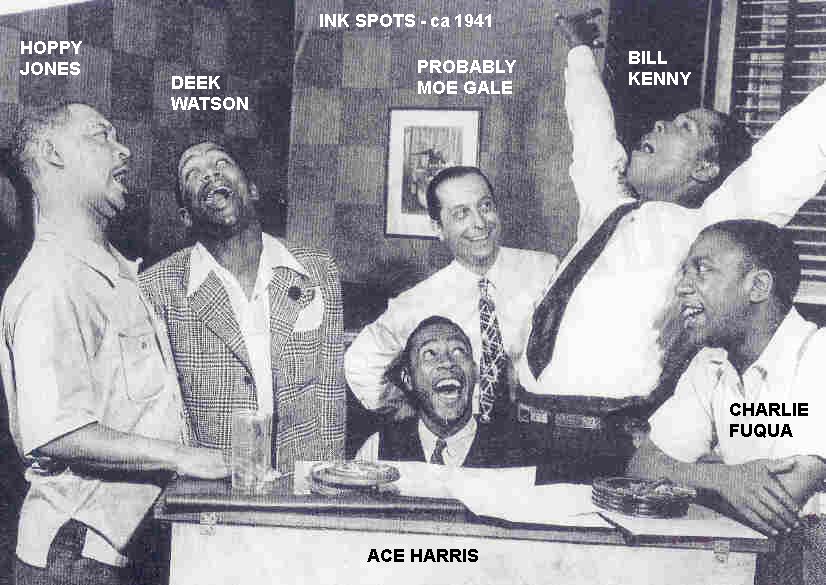
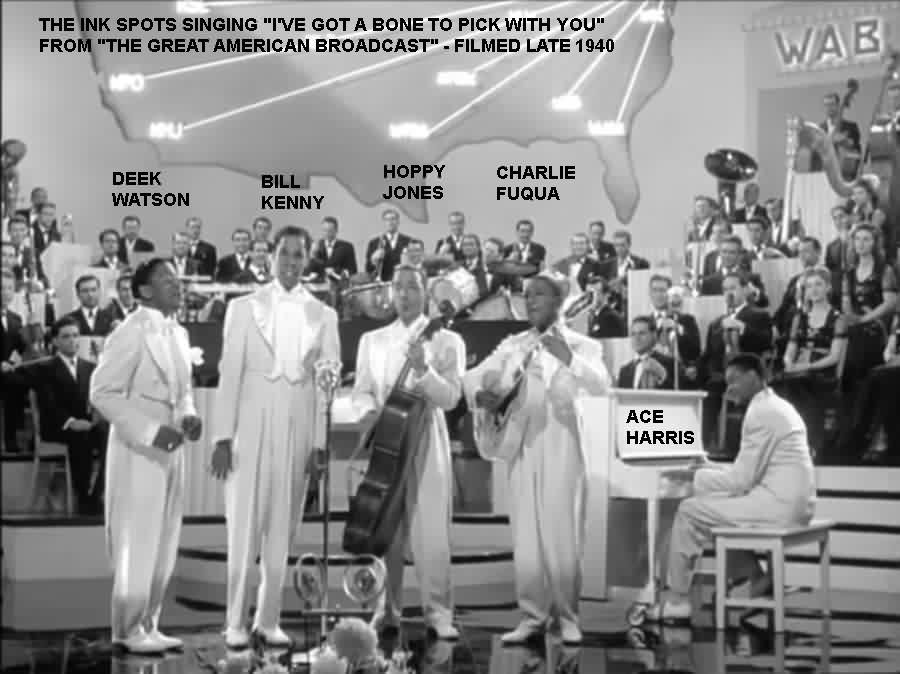
Kenneth Walter "Ken" Bryan - was the original replacement for Ace Harris. He appears in a 1942 photograph (below), taken on June 24, when they were appearing at Pittsburgh's Hill City Ballroom. In the photo, they're plugging a song called "A Yankee Doodle Tan", part of the Pittsburgh Courier's "Double V" campaign to win Victory in the wars against fascism and racism. (You can see the double "V" symbol on the covers of the sheet music they're holding.) The caption to that photo calls Bryan "the new arranger and accompanist for the Inks". I wasn't able to find out much about him. According to four censuses and a ship manifest, he was born in New York City in 1913, and, in the 1940 census, he was a "musician".
Ken had been the pianist with Floyd Ray's Orchestra from at least 1938 and was on a couple of their 1939 Decca recording sessions (for example, "Three O'Clock In The Morning"). He was mentioned in this useless sentence in the November 19, 1938 Pittsburgh Courier: "Shirley Green, Kenny Bryan, Eddie Vandevere also of Floyd Ray's ork left many a broken heart". Since Floyd Ray's pianist in October 1939 was Nathaniel Walker, Bryan was gone by that time. (In the 1940 census, another member of Bryan's household was saxophonist Carroll "Stretch" Ridley, who was also with Floyd Ray's Orchestra.) In September 1941, Bryan was part of a swing/boogie woogie duo (along with drummer Baer Smith) playing at the Barbary Coast (New York). In July 1946, he recorded with the Jesse Price Orchestra in Los Angeles ("Sleepy Baby Blues" on Capitol). 1952 found him playing accordion with trombonist Snub Mosley, in a USO tour group to Japan that also had former Ink Spot guitarist Huey Long and singer Alberta Hunter. After this, in the spring of 1953, he appeared with Coleman Hawkins at Cafe Society in Greenwich Village. In early 1957, he returned from Tokyo (I suppose it was with some band, but I don't recognize any other names). I can't find any mentions of him after this.
Since the photo was taken on June 24, 1942, I had to reconsider who was the accompanist on the three 1942 Ink Spots sessions (May 19, June 23, and July 28). It turns out that Bill Doggett was still recording with Lucky Millinder as late as July 29 and therefore didn't join the Ink Spots until after that time. Thus, it's Bryan on those and not Doggett (who was on the 1943 and 1944 sessions).
Note: the way Bryan is dressed in the photo below bears out something that Bill Doggett told me: although the Ink Spots were known for their on-stage wardrobe, he was never dressed to match. While they bought him good (and expensive) suits, he was never made to feel like an actual member of the group, only a hired outsider. (I suppose in the photo above from "The Great American Broadcast", Hollywood insisted that Ace Harris match the rest of the group, although they're wearing tails and he isn't.) Unfortunately, when I spoke with Bill Doggett, he remembered replacing Ace Harris in 1942, but never mentioned Ken Bryan, who couldn't have been there for more than a couple of months.
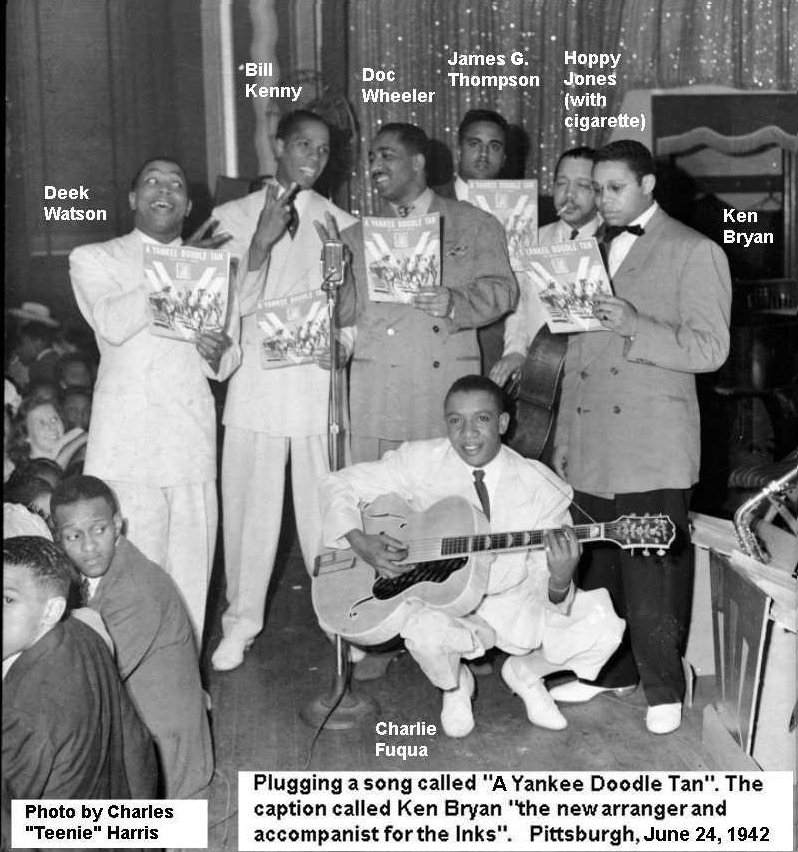
This is actually a strange photo. James G. Thompson (the "Double V" campaign director, behind Doc Wheeler), Hoppy Jones, and Ken Bryan seem like they'd rather be somewhere else, while Deek, Bill, Charlie, and Doc Wheeler have gotten into the spirit of things.
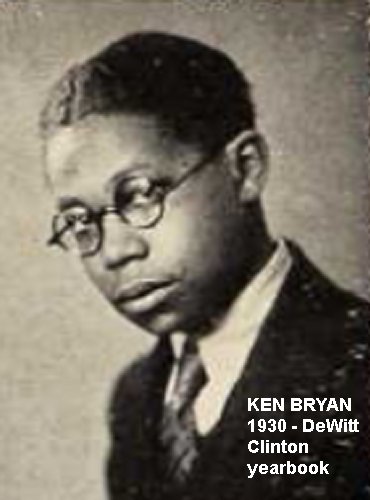
Bill Doggett - Just to reiterate, the accompanist on the 1942 Decca sessions is Ken Bryan. His replacement, Bill Doggett, would be on the 1943 and 1944 sessions.
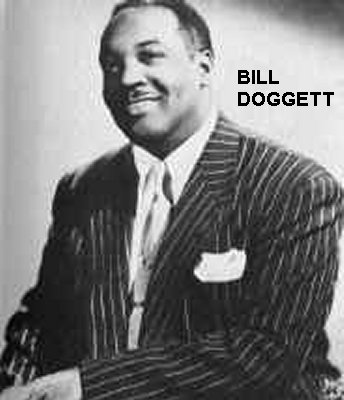
Ray Tunia - had been with the orchestras of Doc Wheeler, Chris Columbus, and Tab Smith. He turned up with violinist Stuff Smith in April 1943, and from there, briefly went with Lucky Millinder before joining the Ink Spots.
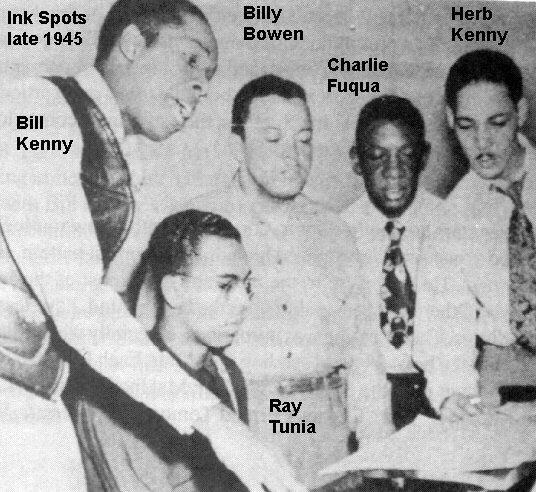
Bill Kenny's Competition - on page 30, I mentioned that Bill Kenny wasn't the only singer considered to replace Jerry Daniels; the other was Chuck Richards (a singer with Lucky Millinder's Mills Blue Rhythm Band, who gave it up in 1942 to become a disk jockey on Baltimore's WITH [and later on WBAL]). Lots of online sites say that he first became a lion tamer, a claim that I find absurd (you'd think that a February 8, 2009 article about him in the Baltimore Sun would have mentioned that; besides, he's listed on WITH beginning in August 1942). I imagine that there was a lion tamer with that name, but, if so, I can't find any trace of him. Also, a black lion tamer in the 1940s would have been picked up by all the black newspapers. I finally found a photograph of Chuck. You can hear him sing "Solitude" on YouTube.
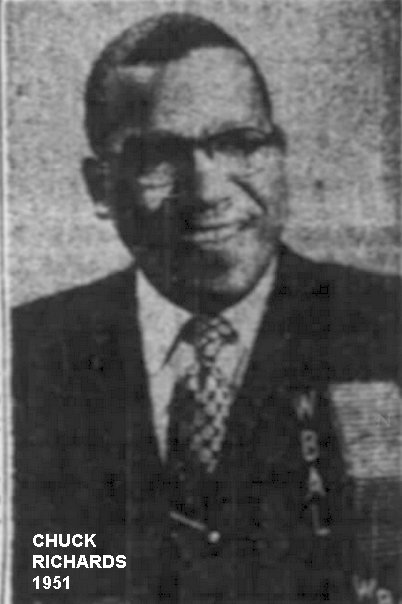
Herb Kenny and Adriel McDonald - Adriel told me that they were both non-recording members of the Cabineers before being associated with the Ink Spots. I finally found a photo of that group; it ran with a December 1944 ad:
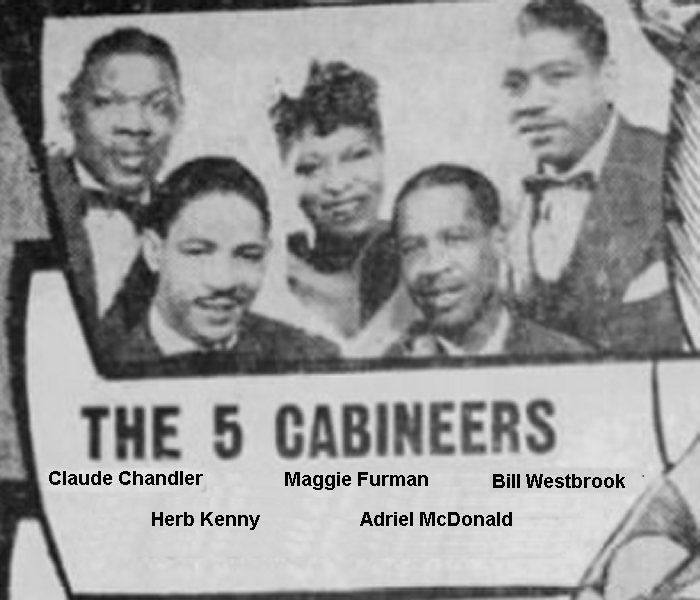
Harold Jackson - Bassist Harold Jackson was one of the many, many performers who claimed, over the years, to have been with the Decca group. As with all the others, I disputed that claim, since he was never mentioned as being part of the Ink Spots before joining Charlie Fuqua's group in late 1952 (he'd recorded with Wilbur De Paris' Band in September of that year). However, I've recently discovered an autographed wine list (see below), signed during an appearance at the Valley Arena in Holyoke, Massachusetts, in January 1949: Bill Kenny, Billy Bowen, Charlie Fuqua, and Harold Jackson. Since he signed it, he was there. I suppose he was used as a temporary replacement for Herb Kenny.
Harold's history is very hard to track. Take his birth. He was born, say all sources, on October 7, 1910, to Leroy Jackson and Delight Patterson. However, the son born to them on that day (in Elkhart, Indiana) was named Leroy Jackson, Jr. per his birth record. Since there's no further trace of Leroy, he must have been re-named Harold Berlan Jackson for some reason. His father seems to have died by 1920 and he was raised by his maternal grandparents, in Akron, Ohio.
In 1938, he (Harold B. Jackson) was one of the writers of "If I Thought You Cared", an instrumental recorded by Barney Bigard. Bigard, a clarinetist with Duke Ellington, used some of Ellington's musicians to record under his own name. Jackson claimed to have been with Ellington, and this seems to support it, although nothing lists him as such. He was also supposedly with Cab Calloway, Stuff Smith, and Hot Lips Page, but again, there's nothing written at the time to support this.
In the 1940 census, Harold Jackson, a night club musician, was living in Milwaukee with his wife, Melba (a night club entertainer), and three others who were also night club musicians: Arthur Nobel, George Evans, and Henry Fuqua (who turned out to be, after a lot of digging, the brother of Charlie Fuqua's father). This implies (although without certainty) that Harold knew Charlie Fuqua as early as 1940.
When he was drafted in August 1942, Harold was living in Toledo, Ohio.
In late 1952, Harold joined Charlie Fuqua, Deek Watson, and Jimmy Holmes in Charlie's new Ink Spots. Over the years, he'd also appear with Bernie Mackey's Ink Spots and, finally, his own group.
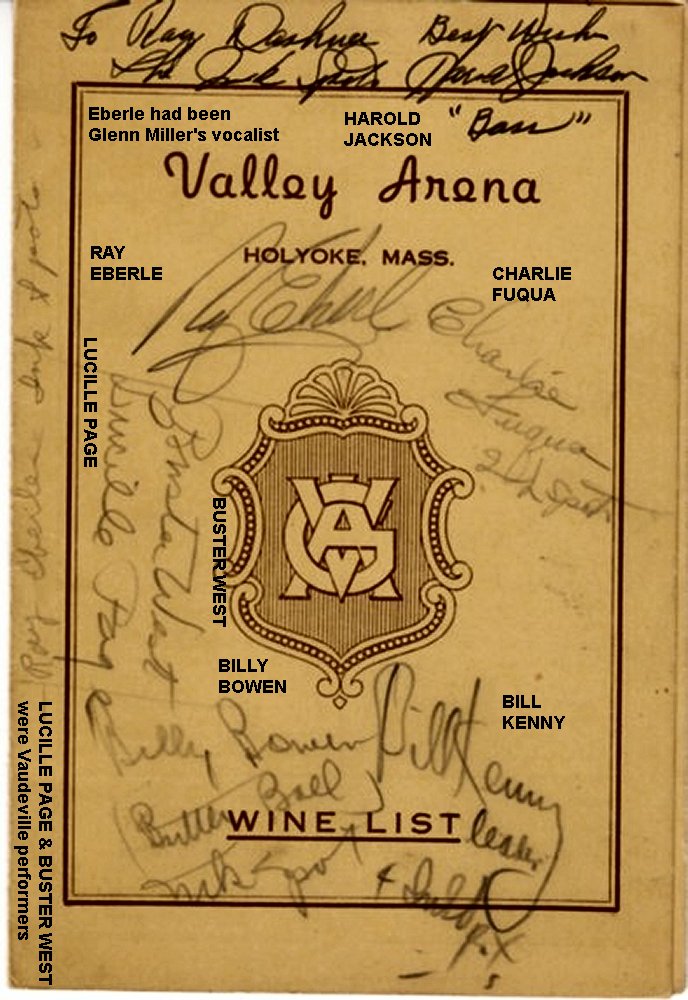
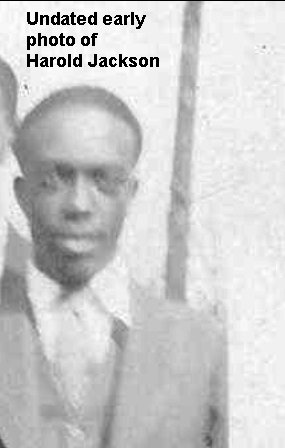
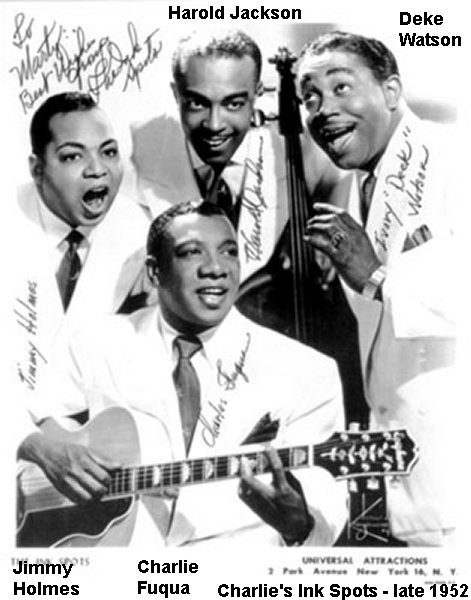
Teddy Williams - Replaced Billy Bowen in early 1952; the Ink Spots were then: Bill Kenny, Charlie Fuqua, Adriel McDonald, Teddy Williams, and Harold Francis. He left around August 1952 [ERROR not in 1953 as it says on page 254], probably as a result of the Kenny/Fuqua breakup; he was replaced by Ernie Brown. A vocalist with Sonny Stitt (sax) on Prestige, 1950-51, Williams had had two records for Federal in early 1951 (with the Federalites on one and backed by Al Cobb's Orchestra on the other). After he left the Ink Spots, he recorded "Bar And Grill Blues" for M-G-M.
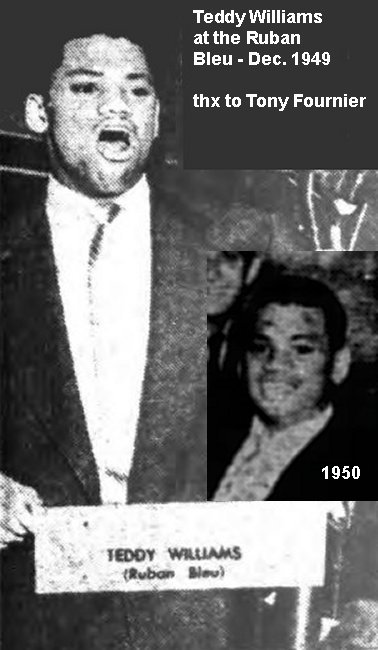
Everett Barksdale - was the original replacement for Charlie Fuqua in 1952. They were then: Bill Kenny, Everett Barksdale, Adriel McDonald, Teddy Williams, and Harold Francis. He was with the Ink Spots for at least one appearance in September 1952 at the Toronto Casino. With Sidney Bechet (1941) and the Jubalaires in 1945. In 1950-1 he's on some Louis Armstrong recordings. In June 1952 he's on a Red Caps session. In December 1952 he's on Capitol recordings of the Art Tatum Trio (with Slam Stewart). 1954-56 - he was a session musician (backed Nappy Brown on "Don't Be Angry," as well as Lavern Baker and Ruth Brown). In 1957, he was with Red Allen, and in 1961, he was a session musician behind Solomon Burke.
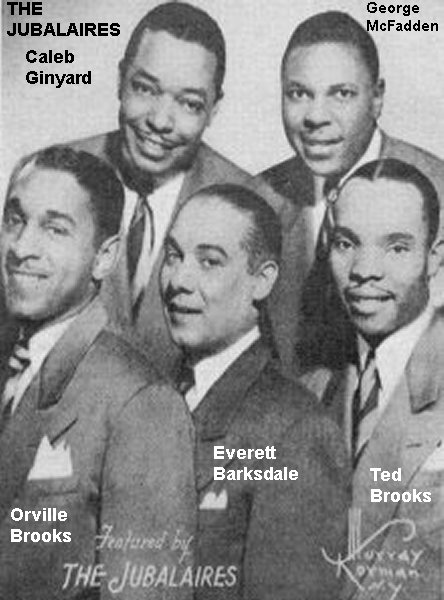
Jimmy Kennedy - ERROR: his name is Jimmy Cannady, not Jimmy Kennedy (I assume that I just misheard what Adriel McDonald said). Although he was referred to as a "new member" (baritone & guitar) in a January 10, 1953 article on the Ink Spots, he'd replaced Everett Barksdale around September or October 1952 (he's correctly identified in the Ed Sullivan picture on page 235, although his name is misspelled). They were then: Bill Kenny, Jimmy Cannady, Adriel McDonald, Ernie Brown (not Teddy Williams), and Harold Francis. Cannady had been with Benny Carter's Orchestra (1947). He'd been in the original Bill Doggett Combo, which recorded for King around April 1952, and had the Jimmy Cannady Quartet, which backed the 4 Brothers & A Cousin on Jaguar in 1954. He became an active session guitarist in the 1950s.
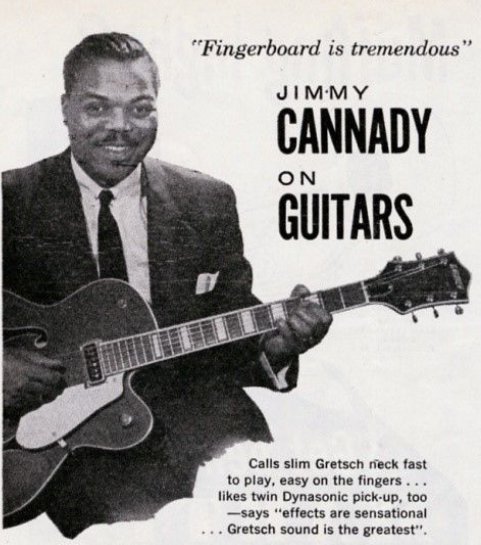
Ernie Brown - Joined in August 1952 to replace Teddy Williams (he's mentioned as being with the Ink Spots at a September 1952 appearance, along with Everett Barksdale). ERROR: the photo on page 235 identifies Teddy Williams in the group; it should be Ernie Brown. He had also been with the Blenders for a while in 1950. In a January 10, 1953 Afro-American article, the Ink Spots were: Bill Kenny, Adriel McDonald (bass), Ernie Brown (rhythm singer), Jimmie Cannady (guitar). Both Brown & Cannady played guitar. In the 1960s, he had the Ernie Brown Trio ("formerly with the Bill Kenny Ink Spots"), based in Columbus, Ohio.
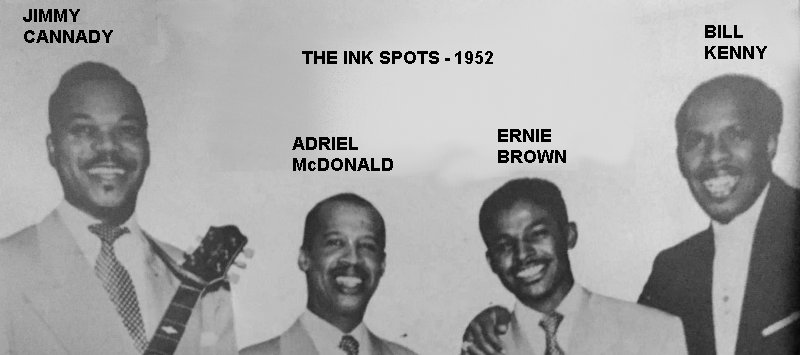
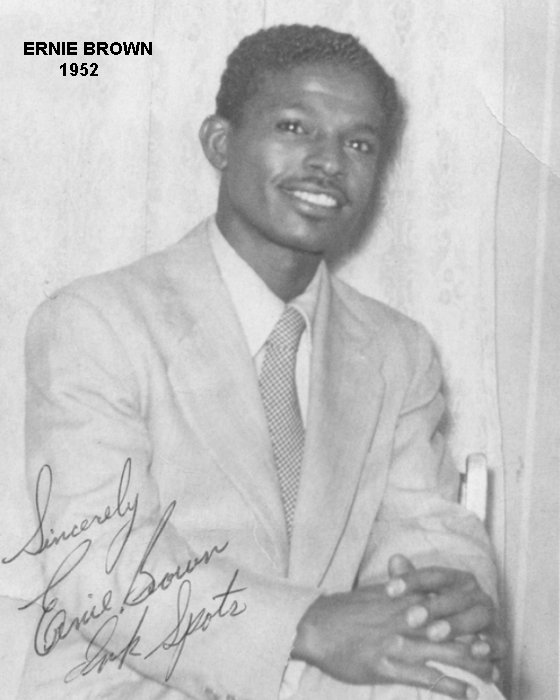
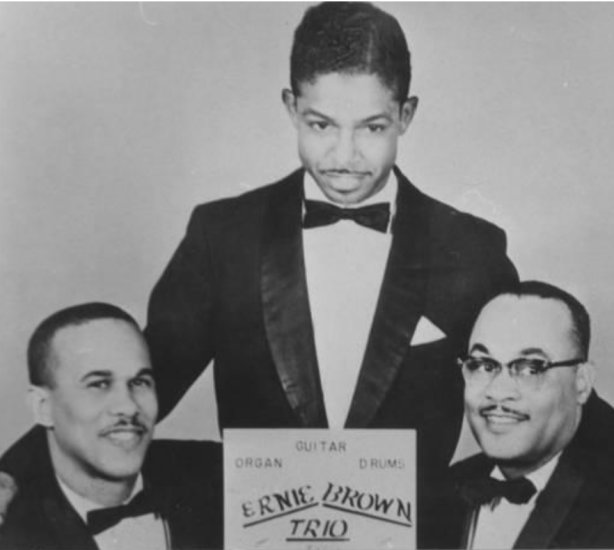
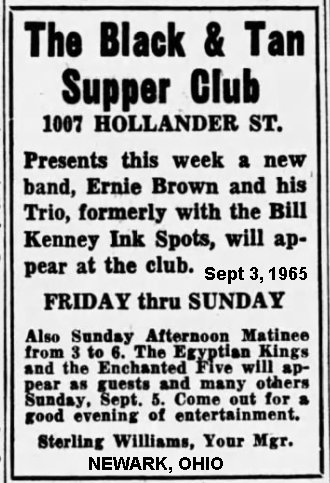
Harold Francis - There's little information about him. In 1938, he played in the Pittsburgh area (Harold Francis & his Jam Band). He was in the army in World War 2 and, when he got out, wanted to enter the New York jazz scene. However, he was unable to get a foothold and joined the Ink Spots instead. In mid-1953, he became Ella Fitzgerald's accompanist and, a year later performed the same function for Orlando Roberson.
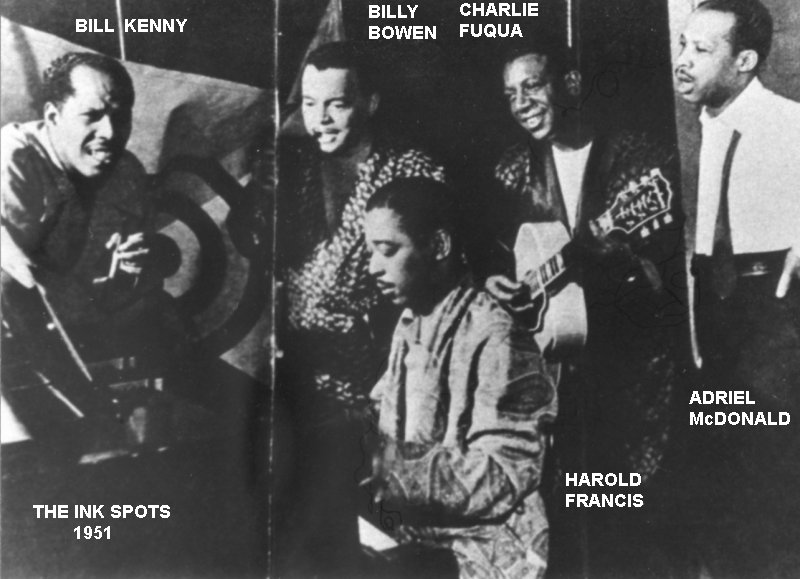
Fletcher Smith (his actual name is Judge Fletcher Smith, Jr.) - Sometime in 1953, at a show in Vancouver, he, Bill Kenny, Jimmy Cannady (guitar), and Ernie Brown (second tenor) signed a napkin, as the Ink Spots. Where was Harold Francis? Had he quit? Where was Adriel McDonald (probably didn't like signing napkins)? In November 1939, Smith had been the pianist with Pete Brown's Jump Band. He was with the Cootie Williams Orchestra in the early 1940s and then with Slim Gaillard's Boogiereeners in 1945 (leads "Queen's Boogie" & "Nightmare Boogie" on Queen). With Earl Bostic in 1950s on King. In 1953, he did Swing Time 329 ("Brand New Neighborhood" and "Mean Poor Girl"). Combo 79 was by Fletcher Smith's Squares in March, 1955 ("Ting Ting Boom Scat"/"A Rolling Heart (Gathers No Love)"). Fletcher Smith remained the accompanist with the Ink Spots until the end, in July 1954.
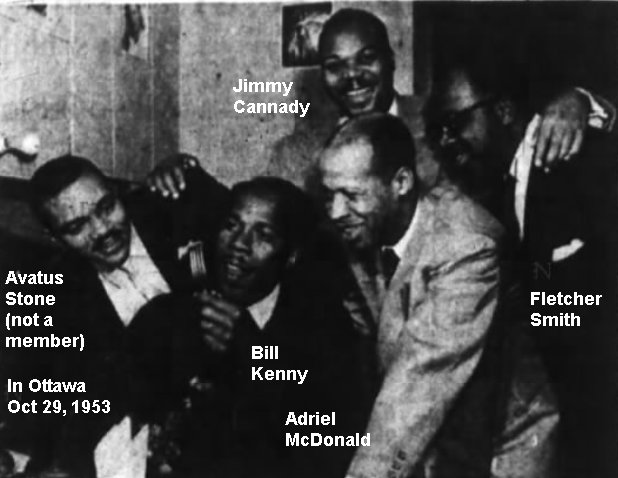
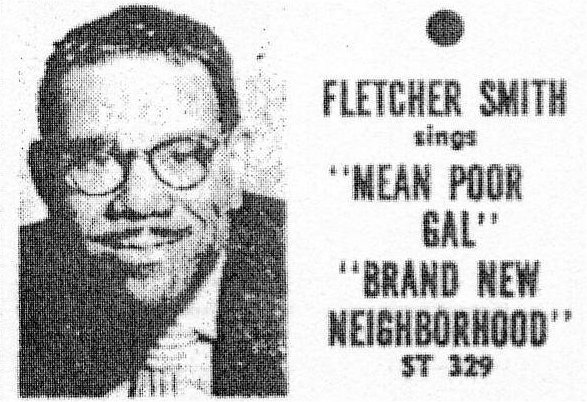
Mortimer "Morty" Howard - here's one I always forget about (mentioned on page 91). Not an actual member of the Ink Spots by any definition, he worked with them to create their vocal arrangements from at least 1939 through 1945 (possibly longer). He was also, from around 1935 to 1958, the accompanist on the Horn And Hardart Children's Hour. In 1942 and 1943 articles (while he was still with the Ink Spots), he said that he'd arranged "If I Didn't Care". This is from the August 1943 edition of Radio Mirror: "In the early days of Vaudeville, Morty says, performers would sing a song, then recite a ballad, then sing again. He arranged the Ink Spots' theme in this fashion and their success was almost instantaneous." If true, this would mean that he'd also arranged "Tune In On My Heart", sung over WEAF on February 15, 1938 and the slightly later "I Wish You The Best Of Everything", two earlier songs that have the same formulaic sound as "If I Didn't Care".
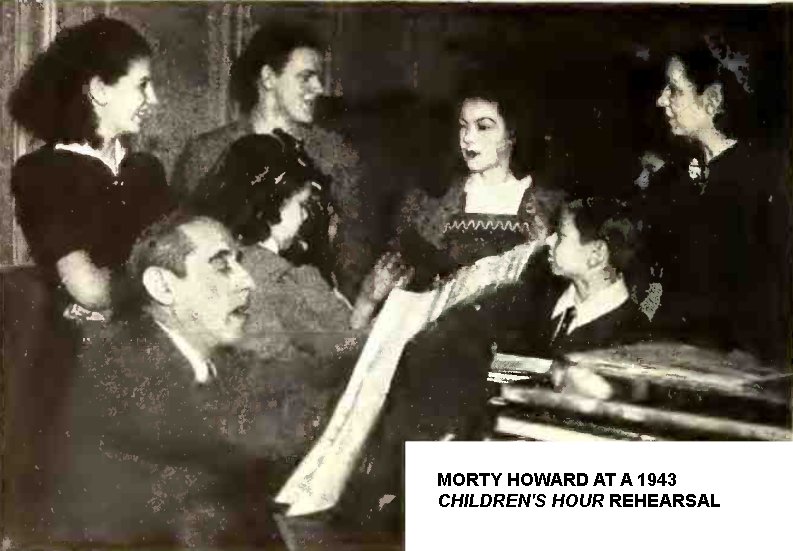
Henry Braswell (William Henry Braswell) - Replaced Ernie Brown as second tenor at the very end. He came on board in April 1954. At the time, the Ink Spots were: Bill Kenny, Henry Braswell, Jimmy Cannady, Adriel McDonald, and Fletcher Smith. This is the last of the Kenny groups. According to Braswell, their final performance was in Wildwood, New Jersey, when Bill Kenny informed them that he was dissolving the group. This is how it all ended:
In June 1954, Kenny and the Braswell-Cannady-McDonald-Smith group did a live appearance with Ed Sullivan in Connecticut. Everything went well and Sullivan asked the group to appear at a show for returning Korean War veterans to be held on his July 4 TV program. Kenny accepted, and then privately informed the group that he couldn't afford to pay them for the appearance, so he was going alone. The unusual thing about this is that Kenny had always taken the group along and paid them, even when he didn't let them perform. Sullivan was so angry about the group not being present on his show that he placed Kenny nearly at the bottom of the bill, headlining the Step Brothers instead. They disbanded after an appearance at the Bolero Bar, in Wildwood, New Jersey, that ended on July 14.
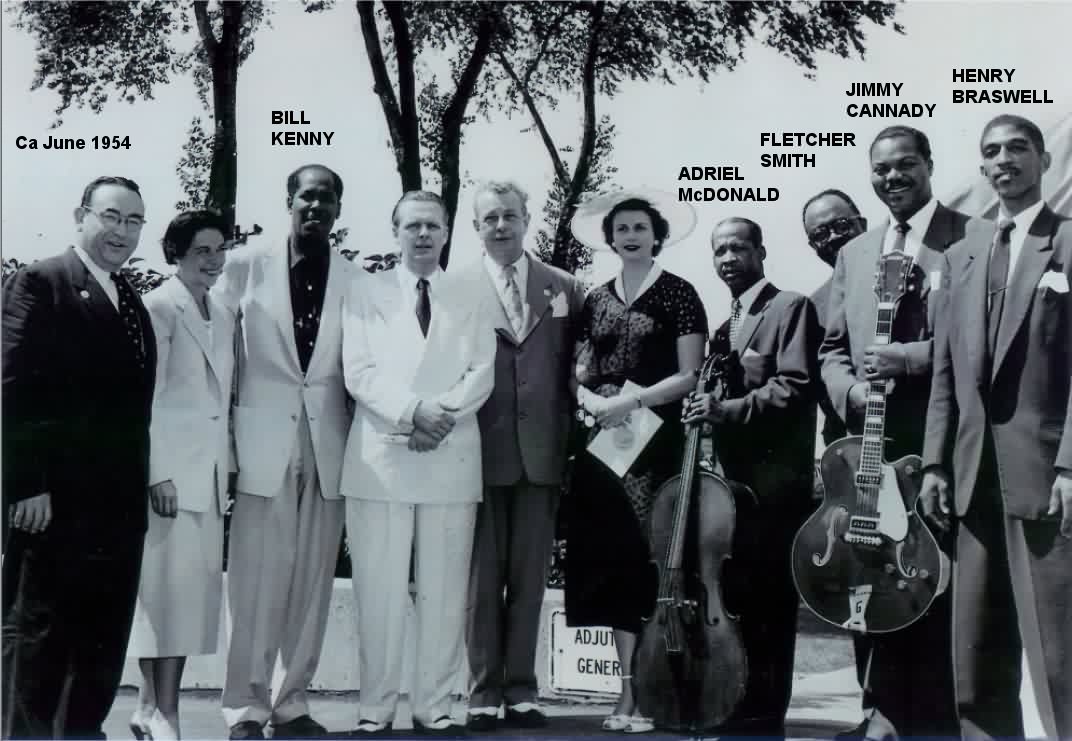
The Ink Spots' Other Screen Appearances - "The Great American Broadcast" was released in May 1941; "Pardon My Sarong" was released in August 1942.
Tip, Tap And Toe (the dancers in "Pardon My Sarong") are Raymond Winfield, Sammy Green, Teddy Fraser.
Brown Dots - ERROR - page 155. Manor 1163 is by the first Brown Dots group, not the second. Additionally, there was the Brown Dots on Brown Dot 298 (a New York label) ca. 1950: "I've Loved You So Long Baby" (298A)/"The Devil Beating His Wife" [sic] (298B). The 4 Dots on Castle seems to have been reissued on a 45, for some reason, around 1952. Deek did two solos on Jubilee 5138 (February 1954) as "Deek Watson, The Brown Dot": "Brown Gal" (JB-1-300) and "Why Does A Drink Make You Think" (JB-1-299). (Note that some copies have him as "Deek Watson, The Ink Spot".)
Hoppy Jones' wife - ERROR - page 133. Hoppy's wife was Esther Vivian Zippin from Cincinnati, not Esther Golden.
Royalty Payments - Ever wonder how much Decca paid them in royalties? This was in the June 19, 1943 Michigan Chronicle, under the heading "Ink Spots Paid $21,111 By Decca":
PHILADELPHIA - (ANP) - The Ink Spots, highest paid of Decca's Negro recording stars, received $21,111 from that firm in 1942, according to the company's annual report to the Securities and Exchange Commission disclosed Tuesday.
There really wasn't much activity in 1942. "Someone's Rocking My Dream Boat", released in late 1941, would have sold well into 1942. Their only other chart hit that year was "Ev'ry Night About This Time".
Butterball Four - ERROR - page 238. The photo identification for the Butterball Four is incorrect. It should read: (Left To Right) Melvin Moore, Billy Bowen, Eddie Thompson, Kelly Owens, Clyde Austin.
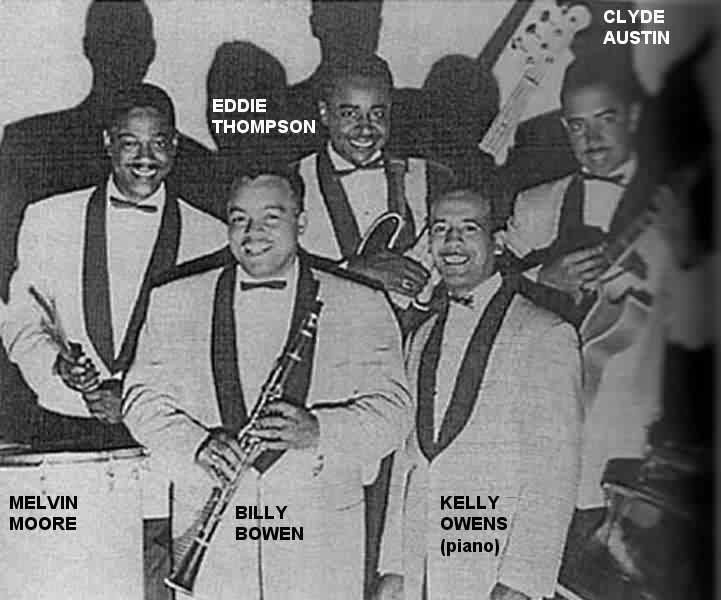
ERROR - page 127. Says "Kenny also countered"; it should say "Gale also countered"
ERROR - page 180, in the Note in the middle of the page, "it's" should be "its". (Neither I nor the proofreader caught this one. Sorry.)
Huey Long - ERROR - page 271 - Huey Long turned 94 in 1998, not 93. He died in June 2009 at the age of 105.
Charlie Fuqua returns from the army - On page 158, I said "When Charlie Fuqua returned from his army stint in late 1945 (or early 1946)...." The November 10, 1945 Indianapolis Recorder documented his return: "After a two-year hitch in the Army, Charlie Fuqua, guitar-strumming baritone of the Ink Spots quartet, shed his khaki last week and returned to his spot with the nation's top quartet. Fuqua rejoined the famous singing group when they opened a limited engagement at Glenn's Rendezvous in Newport, Ky., Friday night." (That was probably November 2, 1945.) However, the November 24, 1945 Cleveland Call And Post said that Charlie's return was to be at the Taft Theater in Cincinnati on November 23. Take your pick, but it was probably some time in November.
Flip Side - ERROR - page 82. The second 20th Century record did have a flip side. The record should be listed as "Bone To Pick" (TCF-57)/"Alabamy" (TCF-58) (these are the actual titles on the disc).
Deek Watson's Career Of Crime - In early February 1927, Ivory Watson was one of several Indianapolis youths arrested in Chicago in connection with car thefts. Subsequently sentenced to a year on the state prison farm, he was lucky; some of his co-defendants got up to 14 years.
Deek's Puppet Show - I mentioned, on page 247, that Deek had a "novelty comedy act" using marionettes that represented famous black performers. Supposedly there were puppets of Bill Robinson, Lena Horne, Billy Eckstine, Pearl Bailey, Josephine Baker, Louis Armstrong, Billy Daniels, the Ink Spots, Ella Fitzgerald, Fats Waller, Sarah Vaughan, Eddie "Rochester" Anderson, Cab Calloway, Nat "King" Cole, Duke Ellington, Lionel Hampton, Nellie Lutcher, Ethel Waters, and Louis Jordan. Here's an ad for the show, appearing in Danville, Virginia on June 19, 1952:
Why Did Jerry Daniels Leave The Ink Spots? It was reported that Jerry left because of illness, but, on page 29, I said that the only thing he was sick of was making so little money. It turns out that both are true. I found an article in the February 15, 1936 Indianapolis Recorder that talked about Jerry returning home because of an unspecified illness. He was brought home by his mother, who'd been in New York with him "for the past few weeks". Looking over my notes from my 1975 interview with Jerry, he actually admitted that he'd been sick, but, because of the lack of money coming in, he "had no incentive to go back". By the time that article was printed, Bill Kenny was a part of the group (he was first mentioned in the February 29, 1936 New York Age). Jerry also said that Bill Kenny had attended an Ink Spots rehearsal while he was still with the group; they all seemed to know that Jerry was leaving. In spite of Jerry leaving, the only photos of the group used through 1938 contained him and not Bill Kenny.
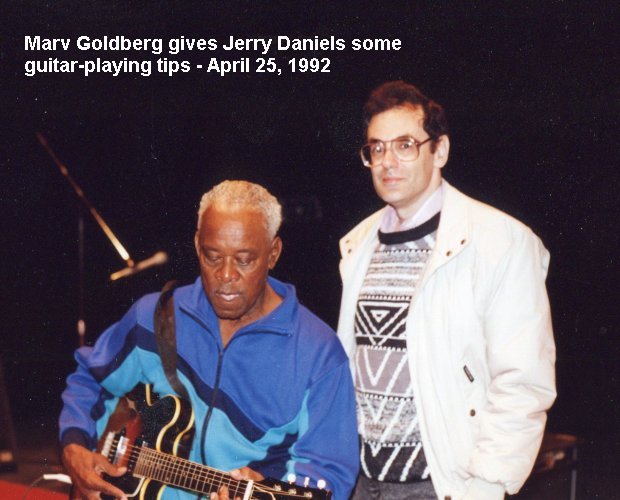
Jerry Daniels and the 3 Spades - They actually did record; Jerry Daniels had forgotten about it completely. There was a single session for Columbia's Vocalion subsidiary on October 21, 1937: "Pan-Pan," "Fu Manchu," "Rusty Hinge," and "Yeah Man". Although Columbia declined to release any of the tunes, "Pan-Pan", written by Jerry, was recorded by Louis Jordan in 1941. Note that, on page 35, I said of the 3 Spades that "They first appeared on WKBF in Indianapolis, then went to WLW in Cincinnati (there was also a spot on WKBF's sister station, WSAI)." It should have said "(there was also a spot on WLW's sister station, WSAI)". I can find listings for them on WLW/WSAI from April 12 through September 22, 1937. They also appeared over New York's WHN; there are listings from July 6 through December 31, 1937. An article in the January 8, 1938 Indianapolis Recorder said that "Al and Wm. Jennings, members of the 'Three Spades', arrived in Naptown last week from New York, where they made a name for themselves in the theatrical world. The boys are visiting their parents, and will leave soon for the big top [?] to join their partner Jerry Daniels, who stayed in New York." This means that both Jerry Daniels and the Ink Spots were in New York at the same time.
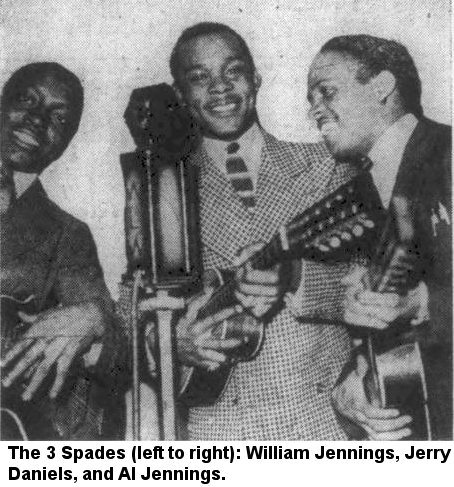
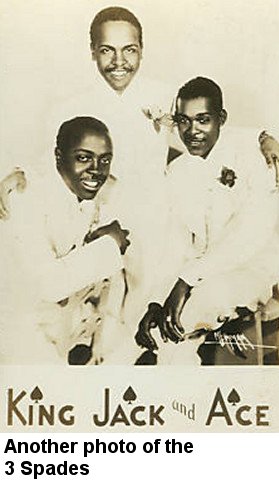
Here's something else Jerry Daniels didn't tell me: in 1938, the 3 Spades became "Duke and the Jennings Brothers". When they played the Southern Cocktail Inn, in Indianapolis, from April through July 1938, they were billed as "Miff and Duke with the Jennings Brothers". Therefore, our old friend Miff Campbell is back on the scene. However, by the time they switched to the Starlite Gardens in October, it was just "Duke and the Jennings Brothers, the Three Spades, who have appeared in New York at the Onyx Club, the Kit Kat Club and Harlem Uproar House [a club at 51st Street and Broadway]."
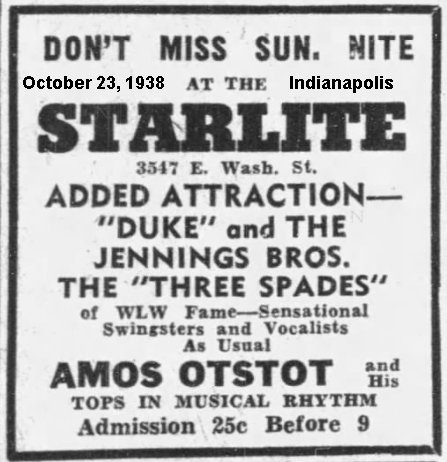
And, there was yet another group he was with. The October 28, 1940 Indianapolis News had this: "The program on the Circle [Theater] opened at 2:30 p.m. with a one-hour concert by the Indianapolis Concert Band.... Other musical selections were provided by Jerry Daniels and his Hot Shots and Red Dickinson and his Hoosier Humdingers." This is the only mention of that group.
Here's an unnamed group mentioned in one of those incomprehensible pseudo-jive-talk columns that appeared in the April 12, 1941 Indianapolis Recorder. At the Cocktail Inn were "16 strings and a fiddle . . . Jerry Daniels, Mifflin Campbell on boxes and Heavy Swain . . . on the fiddle." In English, there was a guitar (six strings), a tipple (10 strings) and a bass fiddle, played by Wilson "Heavy" Swain. All I can tell you about Swain is that, in 1940 he was part of the Wharton Trio, which also had guitarist Orville Hardiman (who'd soon start the 4 Kings & A Queen).
Jerry Daniels and Mr. Words, Mr. Music, and Mr. Strings - Jerry Daniels told me that this was his last group, which broke up in late 1942. He never mentioned that he formed another group with the same name later in the 1940s. The original group had Wendell McMillan (bass) and Donald Overby (piano). The second group had John Watson (bass) and Andrade Amorez (piano).
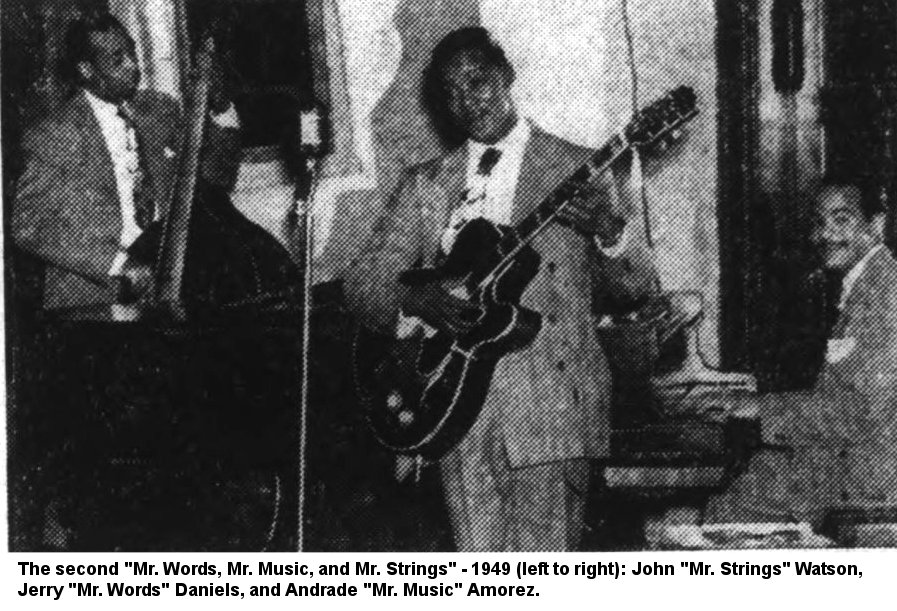
This same photo was printed in the November 24, 1951 Indianapolis Recorder. The accompanying text called them the "Three Strings" and said that they'd appear at the Recorder's Xmas Midnight Benefit Show. Of Jerry, they said: "former member of the Ink Spots, Republican precinct committeeman, and instructor at the McArthur Conservatory of Music."
Jerry Daniels' Street Corner Problems - The August 30, 1930 Indianapolis Times ran an article titled "Six Negroes Jailed After Pan Concert - Police Break Up Musical Program On Kitchen Utensils":
Six Negroes were held on vagrancy charges today after police arrested them as they were presenting a concert on tin pans, coffee pots, and other kitchen utensils Friday night at Meridian and Tenth Streets.
They are: Thornton Lamont, 30; James Reeves, 18; Joseph Rucker, 24; Ernest Brown, 19; Jerry Daniels, 16; and Robert Mailes, 18. [Note that I omitted their addresses.]
No one said the entertainment business was going to be easy.
Jerry was back in February 1931, when the Indianapolis Recorder (February 28) reported that he was part of a band: "Another new orchestra organized among the younger set is the one called the Ten Rhythm Boys. The orchestra is made up of high school boys under the direction of Donald Bundle. They are Herman Twines, cornetist; Roger Jones, banjoist; Scoba Rhodes, Beryl Steiner, Bertram Gardner, David Clark, saxophonists; John Overton, trombonist; Jerry Daniels, drums; Stanley Overton, pianist. These boys someday will be the best in the city among jazz orchestras."
Jerry Daniels - engineer - I found an ad in the December 20, 1927 Indianapolis News that mentions Jerry Daniels endorsing American Flyer trains. He would have been 13 at the time.
Another photo with Jerry Daniels - This photo was printed in the March 21, 1936 Indianapolis Recorder on the occasion of the Spots being added to the "Genius Of Color" radio show [they actually meant "Gems Of Color"], starring Chick Webb and Ella Fitzgerald. (Broadcast coast-to-coast on NBC, Wednesdays, 10:30 - 11:00 PM, Eastern time.) The paper was behind the times, since the Spots were there from the first edition of the show, which had started on January 22. It's an old photo (since by now, Bill Kenny had replaced Jerry, and had probably been on all the "Gems Of Color" shows) and, I suspect, came from their 1934 movie, "Oh, What A Business". It shows, left to right, Jerry Daniels, Deek Watson, Hoppy Jones, and Charlie Fuqua. The paper ran it again on November 6, 1937!
Charlie's big ambitions - In an article in the November 25, 1939 Indianapolis Recorder, Charlie Fuqua said his childhood ambition was to be a shipping clerk!!! It's a shame we can't always realize our childhood dreams.
Charlie Breaks A Leg - Austin Casey sent this photo, taken after Charlie Fuqua broke his leg. It's probably from late July or early August 1943. The caption read: "Pictured above are the famed Ink Spots who are now featured at the celebrity-jammed-packed [sic] Club Copacabana in New York. A broken leg that has kept Charlie Fugua [sic], one of the boys of America's Number One quartet, on the sidelines did not keep the unit from opening and appearing as scheduled." The photo shows Charlie Fuqua, Bill Kenny, Deek Watson, and Hoppy Jones (kneeling).
Bernie Mackey joined when Charlie Fuqua was drafted in September 1943, but didn't seem to be in any photos until around a year later. However, I just found this one, from March 1944:
Bill Kenny Wants To Teach YOU - Are you tired of just listening to the Ink Spots? Want to start your own group? Bill Kenny can teach you how. In this 1947 ad, he promises: "NOW YOU CAN SING!". (And, it'll only cost you a buck.)
Bill Kenny - Has-been - Lucius E. Lee's column in the July 2, 1955 Ohio Sentinel talked about Bill Kenny:
Bill Kenny, with a voice like a cross between a Morton Downey and falsetto, but with the clearest enunciation in show business, couldn't hold the Ink Spots in the spotlight anymore than the Boswell Sisters, the Andrews Sisters, the Southernaires and even the Mills Brothers could keep going forever. No one but the Bingo [Bing Crosby] could do that.
At one time, the Ink Spots would have filled Memorial Hall but now they could hardly fill the Art Gallery's Little Theater room.
The great quartet started a new style for group singing but they kept doing the same thing over and over again until swing music lovers started looking for something new.
Lord Essex Scott (page 240) had been the vocalist with the Earl Hines Orchestra in 1945-6.
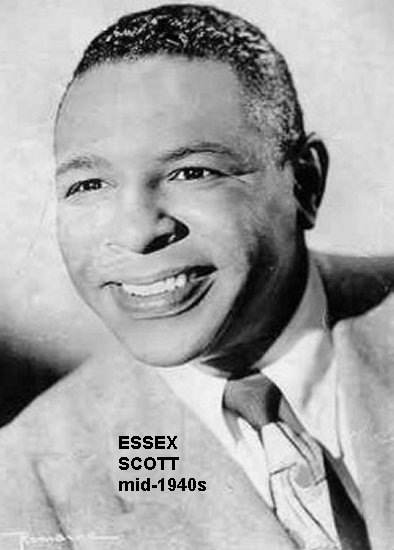
Leon Antoine - ERROR - page 242. His name should be Antoine Leon (there were a couple of newspaper mentions that inverted his name). His nickname was "Lucky".
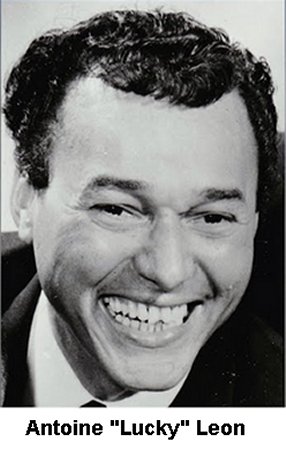
Ella Fitzgerald and the Ink Spots - Carl Jones, of the Delta Rhythm Boys, told Jason Gross in January 2001: "The reason we [the Delta Rhythm Boys] recorded with her was because she refused to record with the Ink Spots anymore. She had recorded a couple of things with them and it turned out very well. But she couldn't stand Bill Kenny showing off behind her on stage when they were performing at the Paramount, flashing his gold rings while she was singing. She said 'I'm not going to stand for that!' Then they had an argument. He said, 'I'm just as popular as you are.' So she refused to work with them anymore. So that's how we came to record with her."
Nicknames - I found an advertisement from October 1938 that gave some nicknames (although "labels" might be a better term). They're so lame, however, that I'm sure they were invented by a press agent.
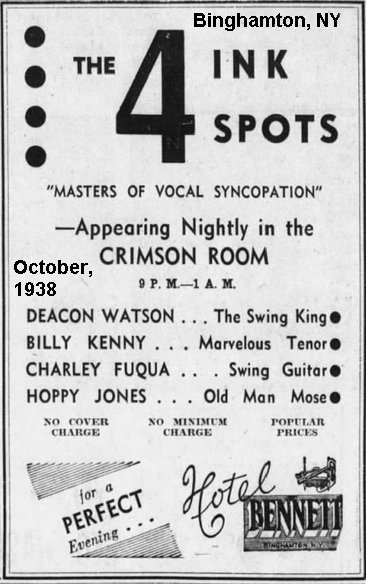
Java Jive - I was asked if I thought that the "tea" in the lyrics of "Java Jive" referred to marijuana. I have to admit that, since I've been familiar with the song since I was a child, the thought never occurred to me before. After mulling it over, I came up with the definitive answer: I don't know. I suppose that it could have been deliberately written to be interpreted both ways: the literal meaning for the squares and the slang meaning for "those in the know". The song itself makes little sense literally (but, of course, who says it has to?). Interestingly, the Ink Spots version wasn't the original; it had been released about six months previously by the King Sisters, singing with the Alvino Rey Orchestra.
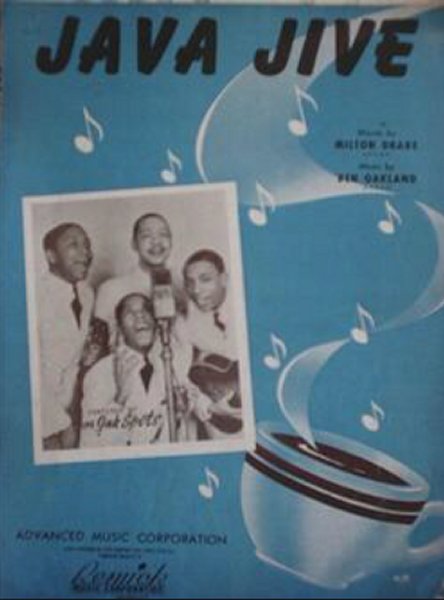
The Moke and Poke Question - On page 119, I admitted to being confused about why some ads said "Moke and Poke" and some said "Coke and Poke". It played out this way: The original dance team was called Moke and Poke (Fletcher Rivers and Leon James, respectively). In December 1944, Leon James became ill. Fletcher Rivers recruited Lew Brown and kept on with the Moke and Poke act. When Leon James recovered, he got Harold Cromer and also started appearing as Moke and Poke. (Of course, it was much, much more complicated than this, since there were now two different managers involved. But that's another story.) It was all settled out of court: Rivers and Brown stayed with the Moke and Poke name; James and Cromer became Coke and Poke.
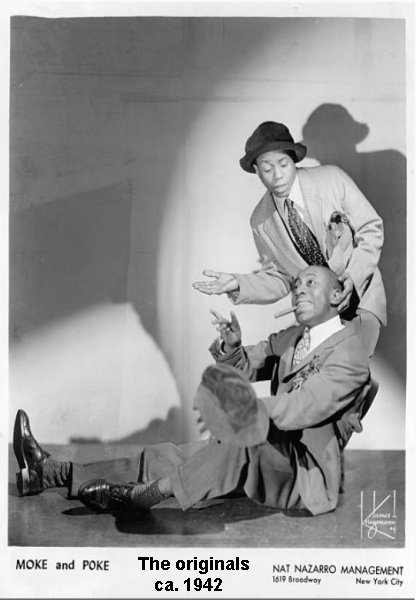
Births and deaths
[NOTE: The first four birthdates are what the members gave on the manifest of the S.S. Aquitania, when they returned from England on December 25, 1934; they don't necessarily tie into other dates you can find.]
When the Ink Spots returned from Europe on the S.S. Aquitania on December 25, 1934, they gave their Harlem addresses as:
Orville Jones - 113 West 113th Street, Manhattan.
Ivory Watson - 2424 7th Avenue, Manhattan.
Charles Fuqua - 182 St. Nicholas Avenue, Manhattan.
Jerry Daniels - 182 St. Nicholas Avenue, Manhattan.